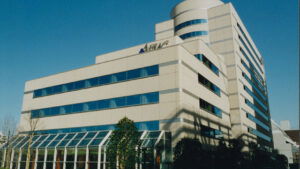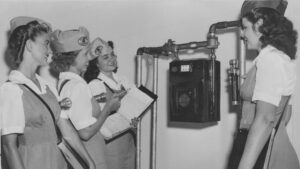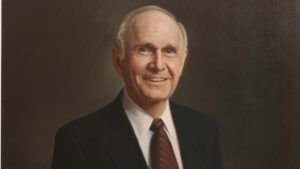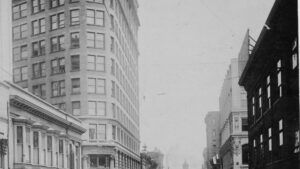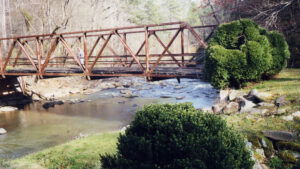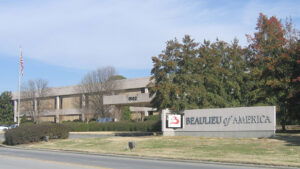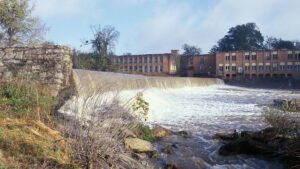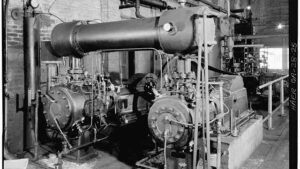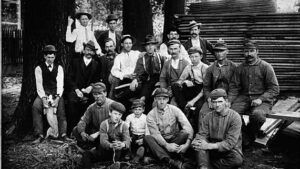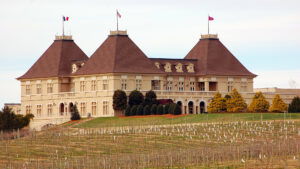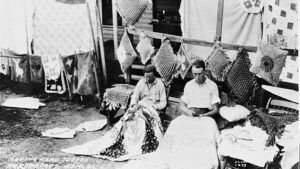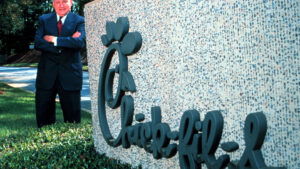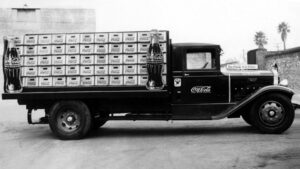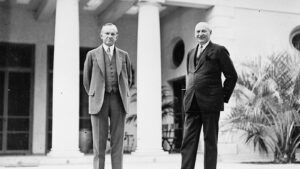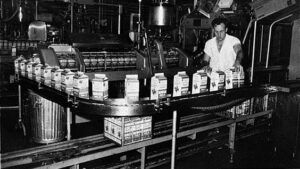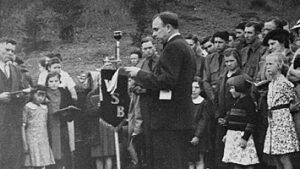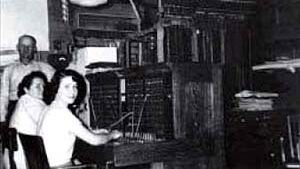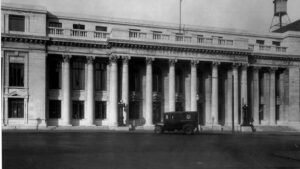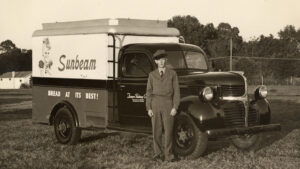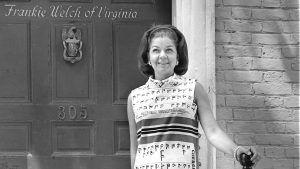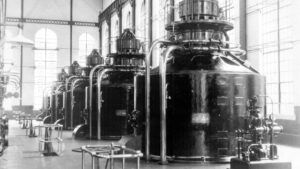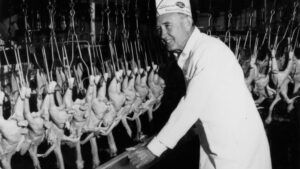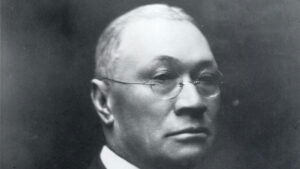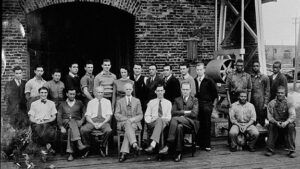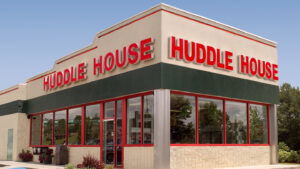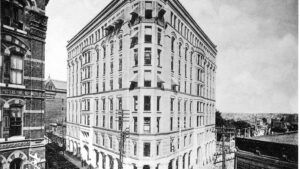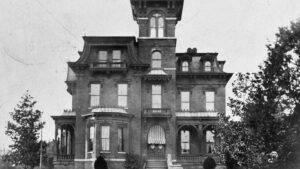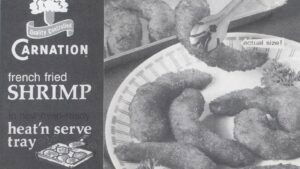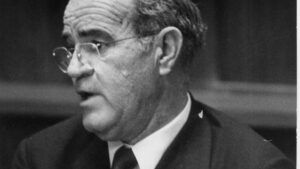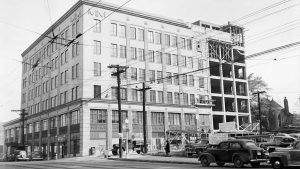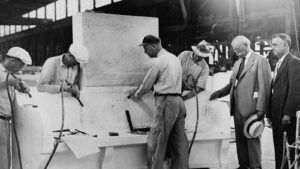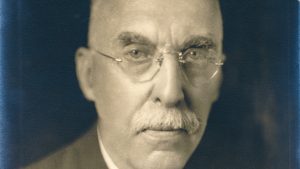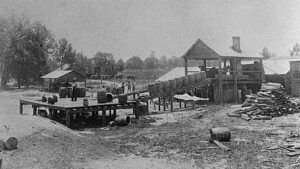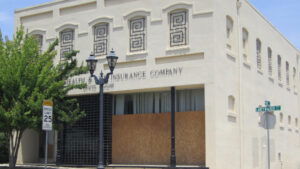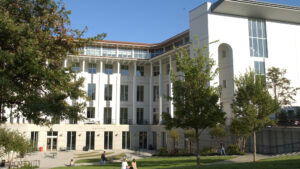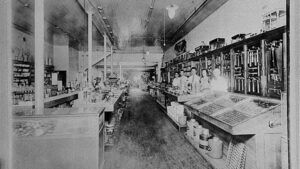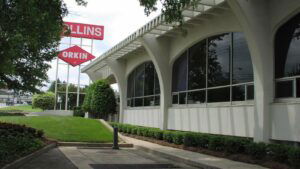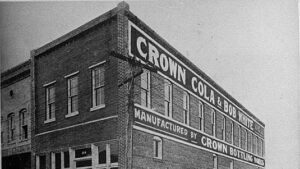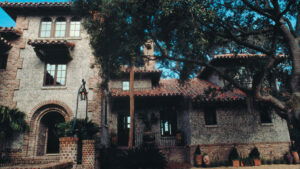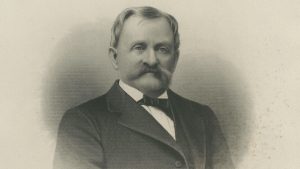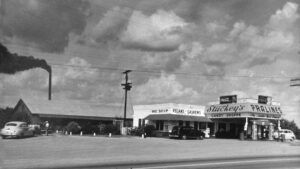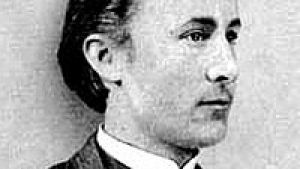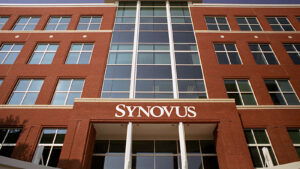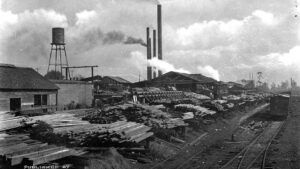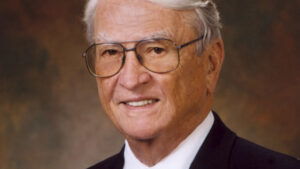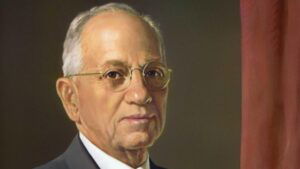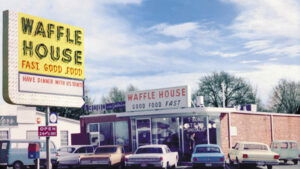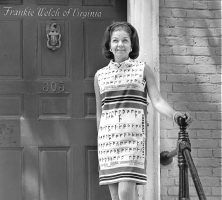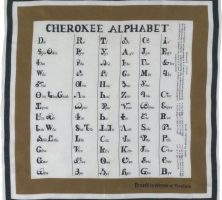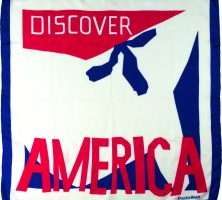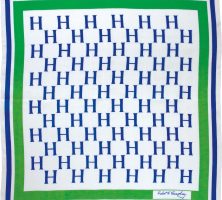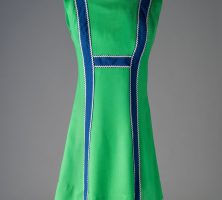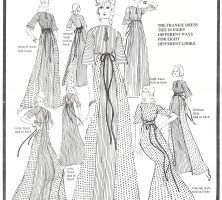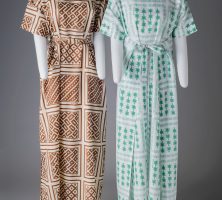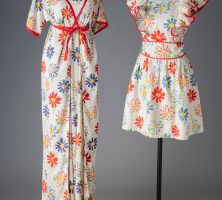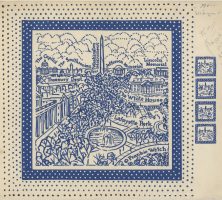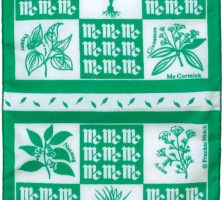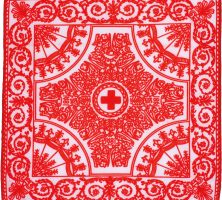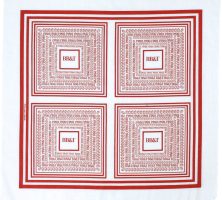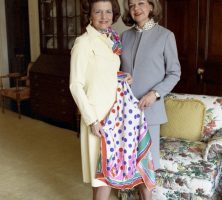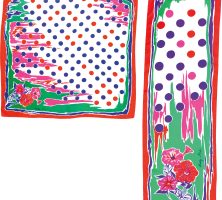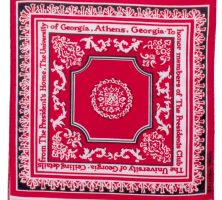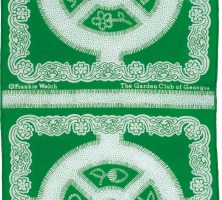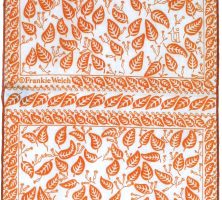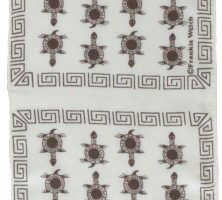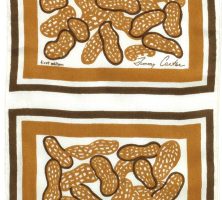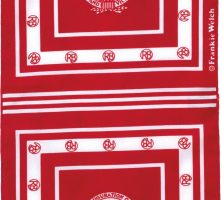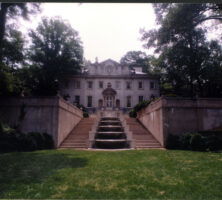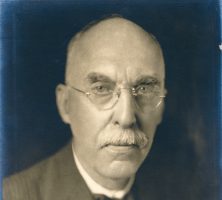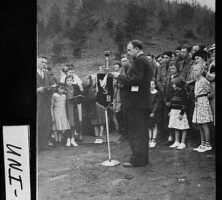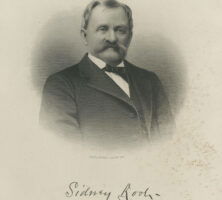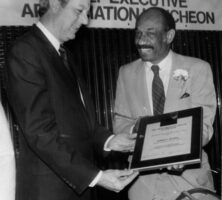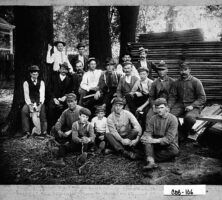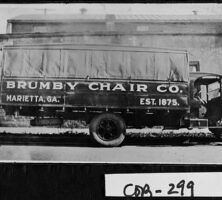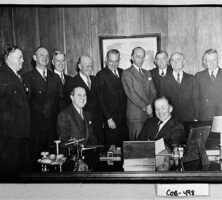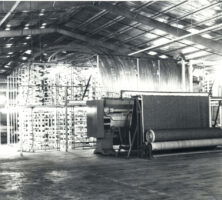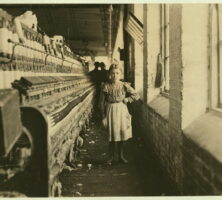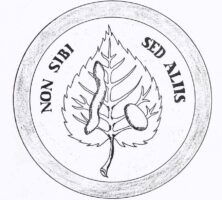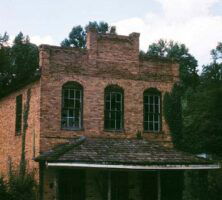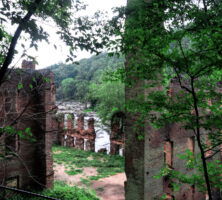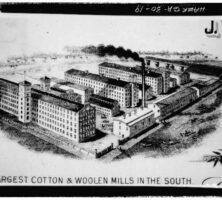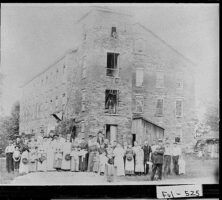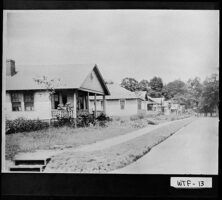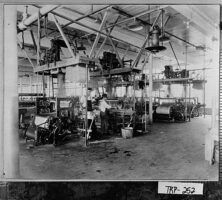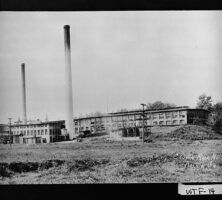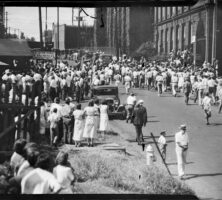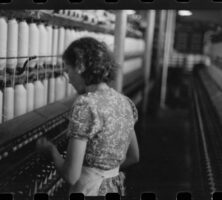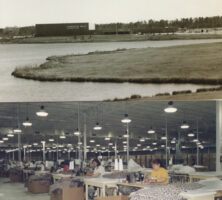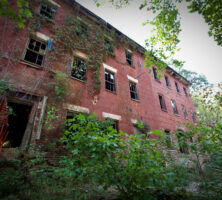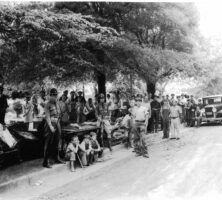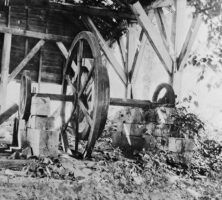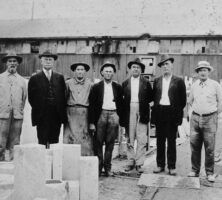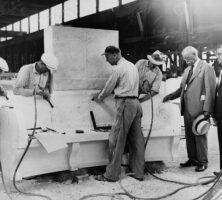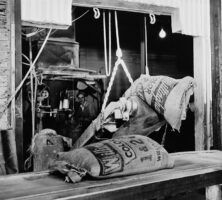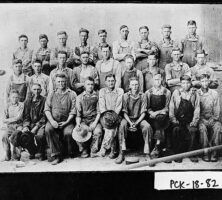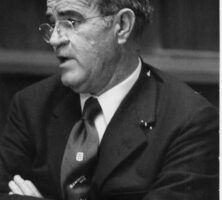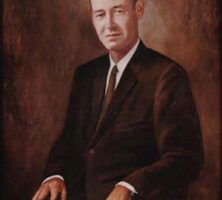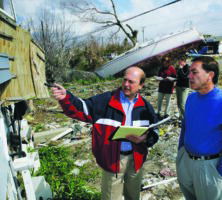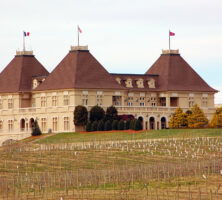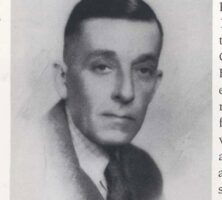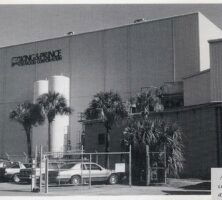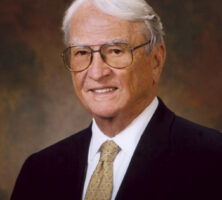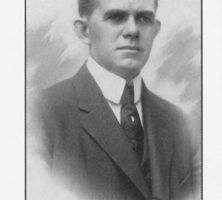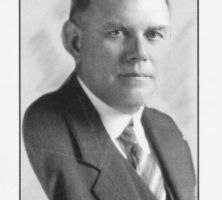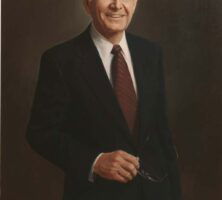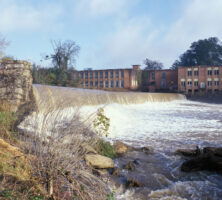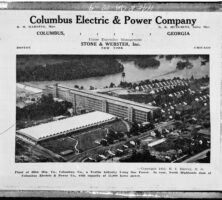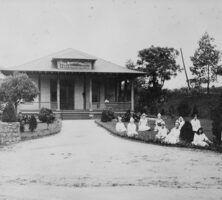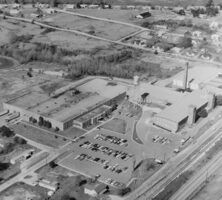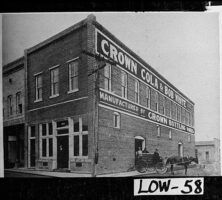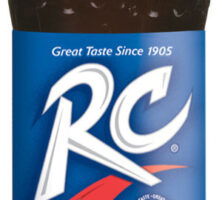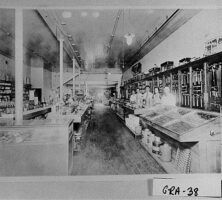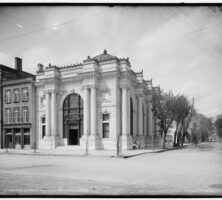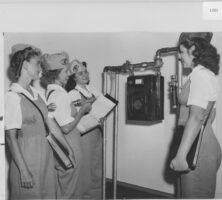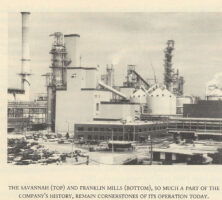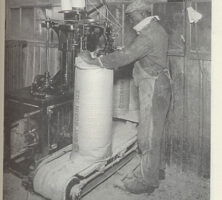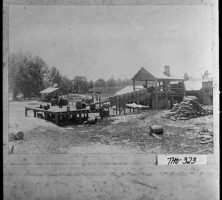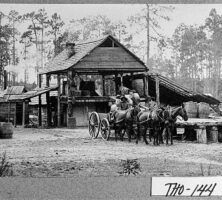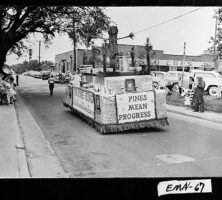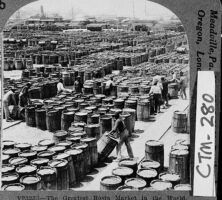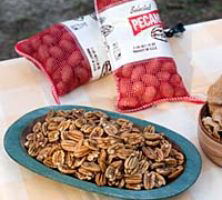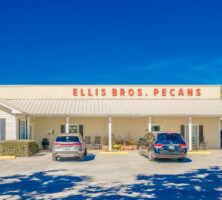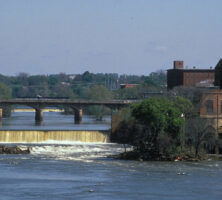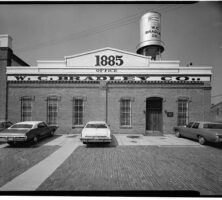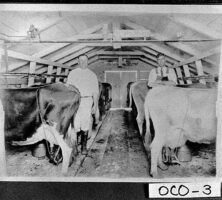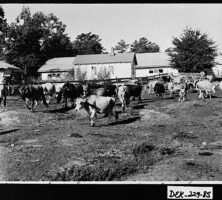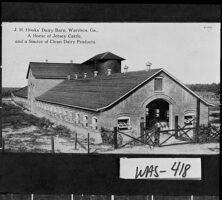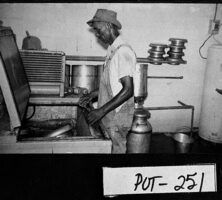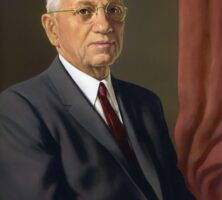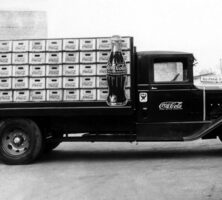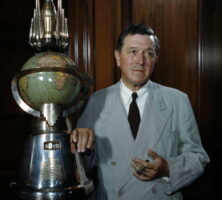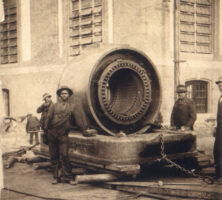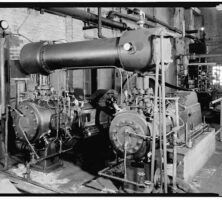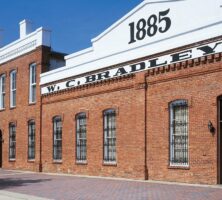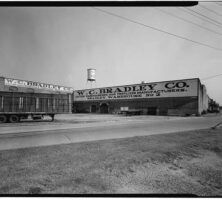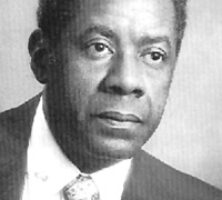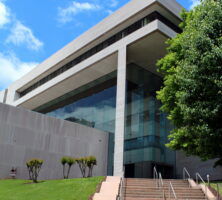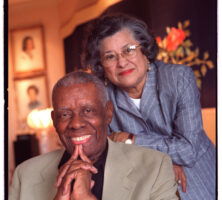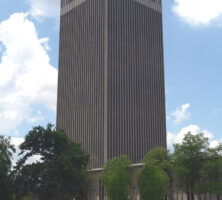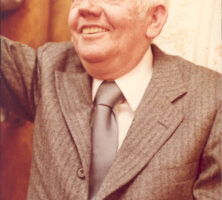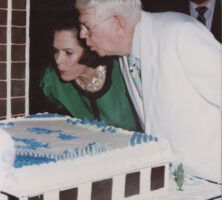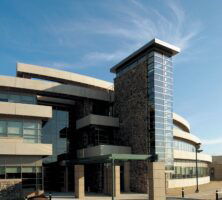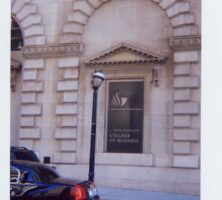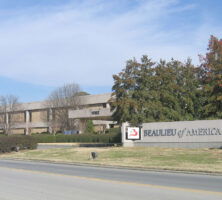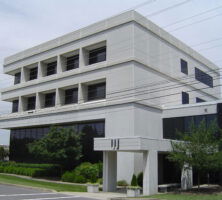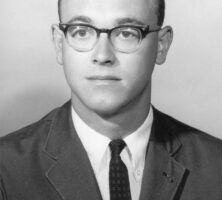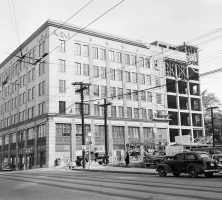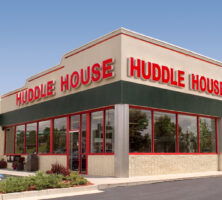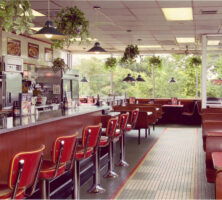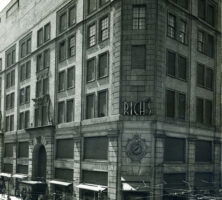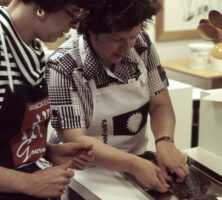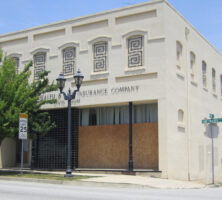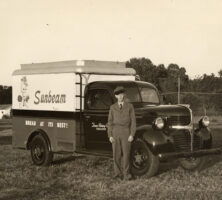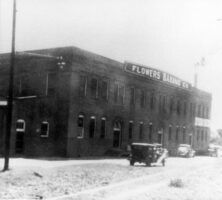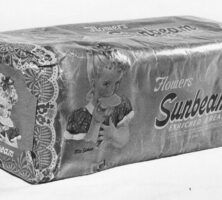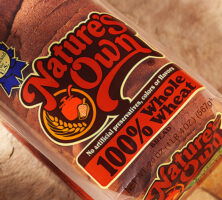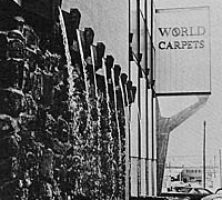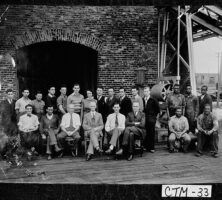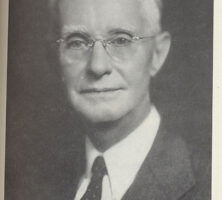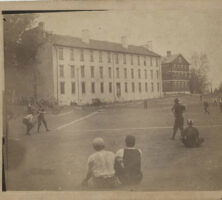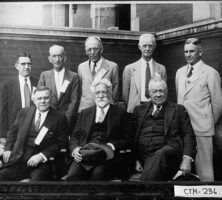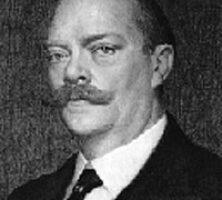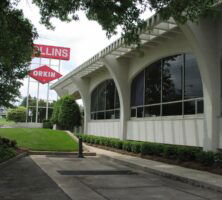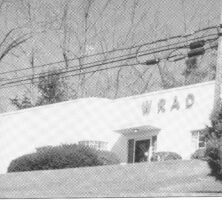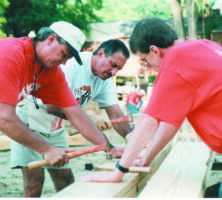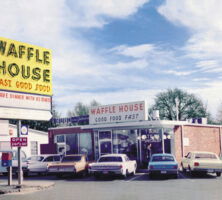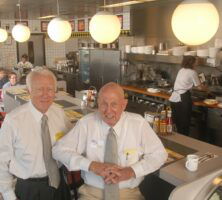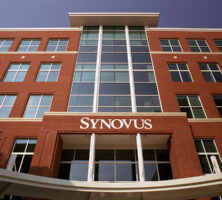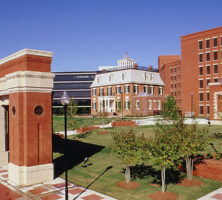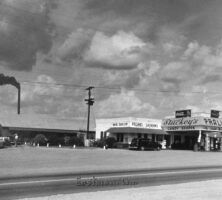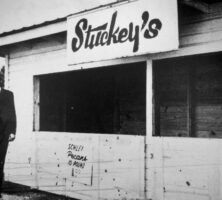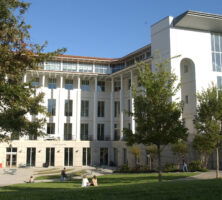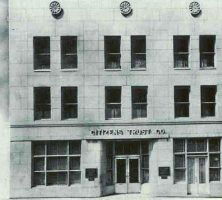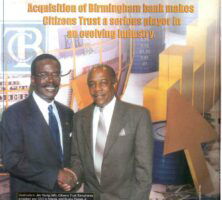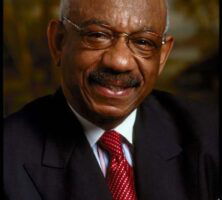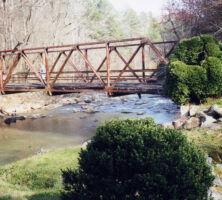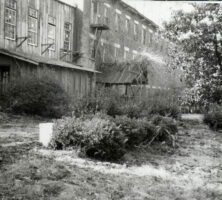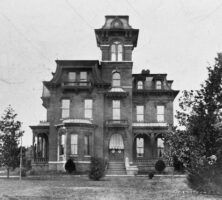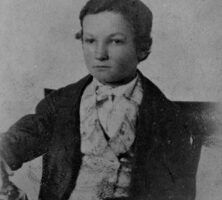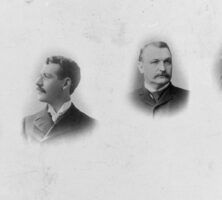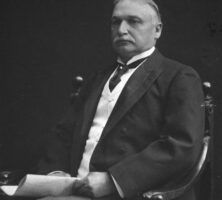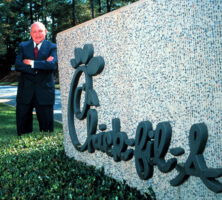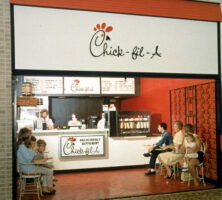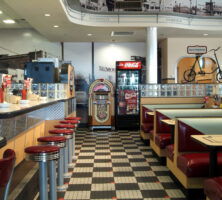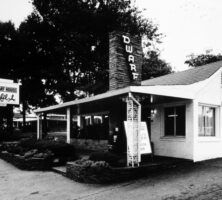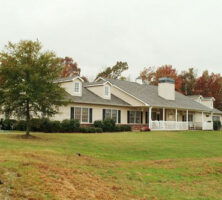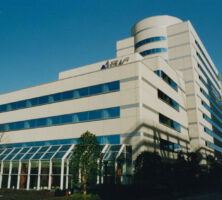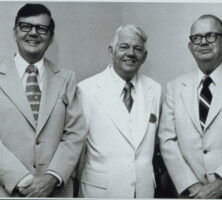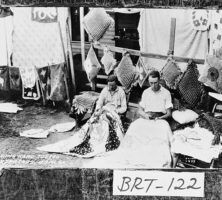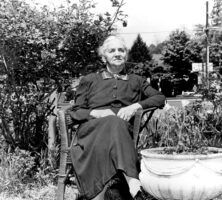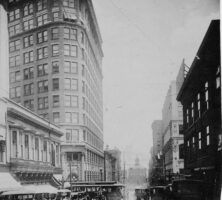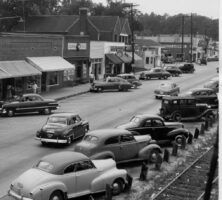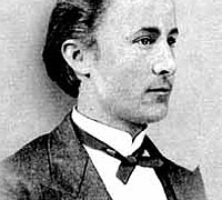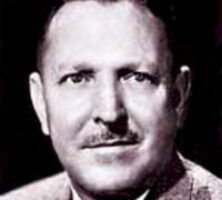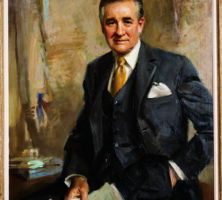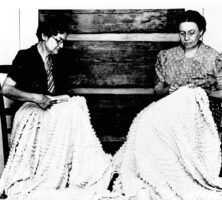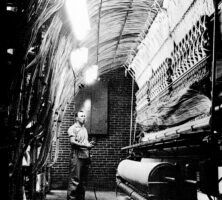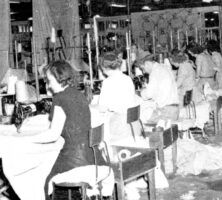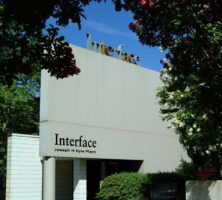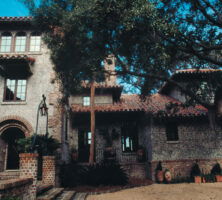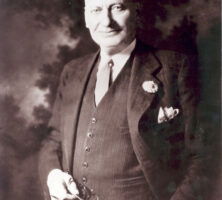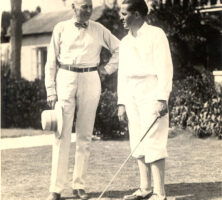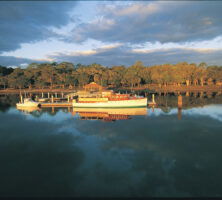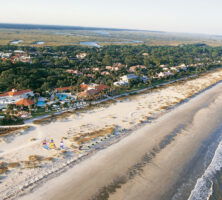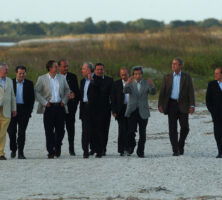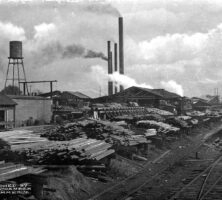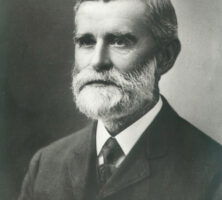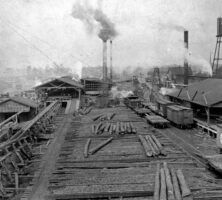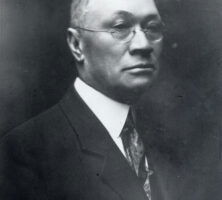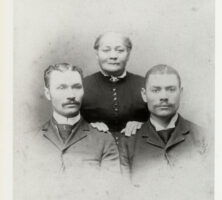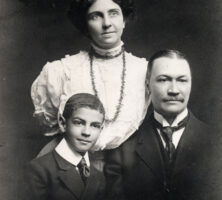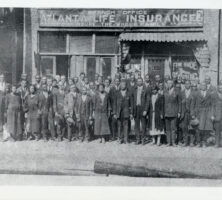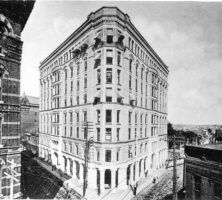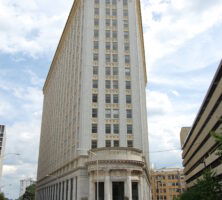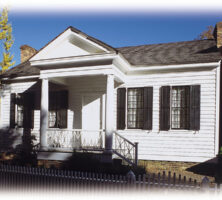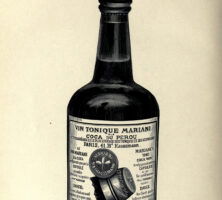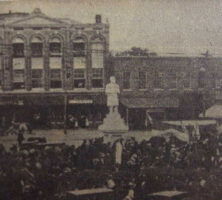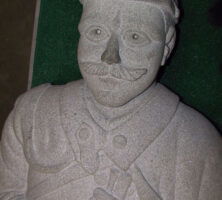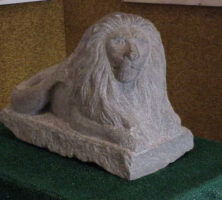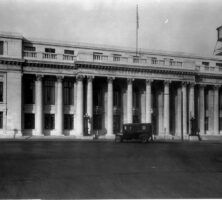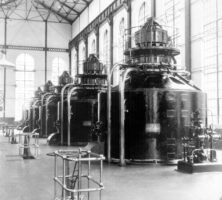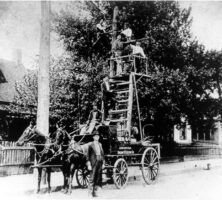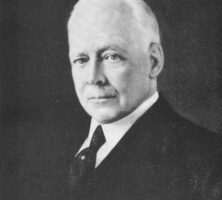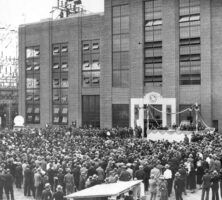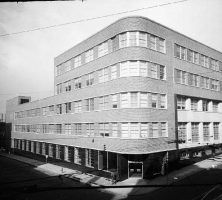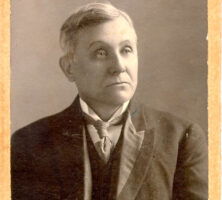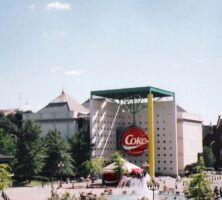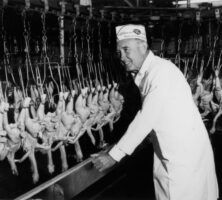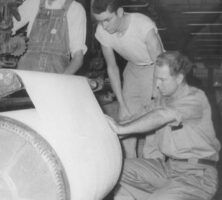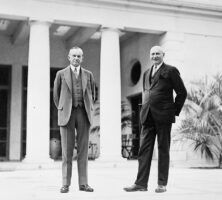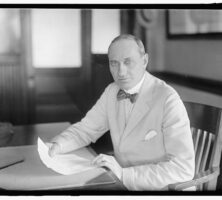The New Georgia Encyclopedia is supported by funding from A More Perfect Union, a special initiative of the National Endowment for the Humanities.
Frankie Welch wearing a Cherokee Alphabet dress in front of Duvall House, Alexandria, Virginia, 1968.
Courtesy of Hargrett Rare Book and Manuscript Library, University of Georgia Libraries, Collection of Frankie Welch, Peggy Welch Williams, and Genie Welch Leisure.
The New Georgia Encyclopedia does not hold the copyright for this media resource and can neither grant nor deny permission to republish or reproduce the image online or in print. Requests for permission to publish or reproduce the resource should be submitted to the Hargrett Manuscript and Rare Book Library at the University of Georgia.
Cherokee Alphabet scarf, 1967, silk.
Courtesy of Hargrett Rare Book and Manuscript Library, University of Georgia Libraries, Frankie Welch Textile Collection.
The New Georgia Encyclopedia does not hold the copyright for this media resource and can neither grant nor deny permission to republish or reproduce the image online or in print. Requests for permission to publish or reproduce the resource should be submitted to the Hargrett Manuscript and Rare Book Library at the University of Georgia.
Discover America scarf, ca. 1968, unidentified fabric.
Courtesy of Hargrett Rare Book and Manuscript Library, University of Georgia Libraries, Frankie Welch Textile Collection.
The New Georgia Encyclopedia does not hold the copyright for this media resource and can neither grant nor deny permission to republish or reproduce the image online or in print. Requests for permission to publish or reproduce the resource should be submitted to the Hargrett Manuscript and Rare Book Library at the University of Georgia.
Hubert H. Humphrey scarf, 1968, silk.
Courtesy of Hargrett Rare Book and Manuscript Library, University of Georgia Libraries, Frankie Welch Textile Collection.
The New Georgia Encyclopedia does not hold the copyright for this media resource and can neither grant nor deny permission to republish or reproduce the image online or in print. Requests for permission to publish or reproduce the resource should be submitted to the Hargrett Manuscript and Rare Book Library at the University of Georgia.
Hubert H. Humphrey dress, 1968.
Courtesy of Ashley Callahan
The New Georgia Encyclopedia does not hold the copyright for this media resource and can neither grant nor deny permission to republish or reproduce the image online or in print. All requests for permission to publish or reproduce the resource must be submitted to the rights holder.
Frankie flyer, ca. 1975.
Courtesy of Hargrett Rare Book and Manuscript Library, University of Georgia Libraries, Collection of Frankie Welch, Peggy Welch Williams, and Genie Welch Leisure.
The New Georgia Encyclopedia does not hold the copyright for this media resource and can neither grant nor deny permission to republish or reproduce the image online or in print. Requests for permission to publish or reproduce the resource should be submitted to the Hargrett Manuscript and Rare Book Library at the University of Georgia.
Basket Weave Frankie and Turtles Frankie, n.d.
Courtesy of Hargrett Rare Book and Manuscript Library, University of Georgia Libraries, Frankie Welch Textile Collection.
The New Georgia Encyclopedia does not hold the copyright for this media resource and can neither grant nor deny permission to republish or reproduce the image online or in print. Requests for permission to publish or reproduce the resource should be submitted to the Hargrett Manuscript and Rare Book Library at the University of Georgia.
Republican National Convention Frankie and pinafore, 1968.
Courtesy of Hargrett Rare Book and Manuscript Library, University of Georgia Libraries, (left) Frankie Welch Collection, Rome Area History Center and (right) Frankie Welch Textile Collection, Hargrett Rare Book and Manuscript Library, University of Georgia Libraries.
The New Georgia Encyclopedia does not hold the copyright for this media resource and can neither grant nor deny permission to republish or reproduce the image online or in print. Requests for permission to publish or reproduce the resource should be submitted to the Hargrett Manuscript and Rare Book Library at the University of Georgia.
Models wearing Clyde’s scarf and tie, ca. 1976.
Courtesy of Hargrett Rare Book and Manuscript Library, University of Georgia Libraries, Collection of Frankie Welch, Peggy Welch Williams, and Genie Welch Leisure.
The New Georgia Encyclopedia does not hold the copyright for this media resource and can neither grant nor deny permission to republish or reproduce the image online or in print. Requests for permission to publish or reproduce the resource should be submitted to the Hargrett Manuscript and Rare Book Library at the University of Georgia.
Fifty State Flowers scarf, 1970, cotton.
Courtesy of Hargrett Rare Book and Manuscript Library, University of Georgia Libraries, Collection of Frankie Welch, Peggy Welch Williams, and Genie Welch Leisure.
The New Georgia Encyclopedia does not hold the copyright for this media resource and can neither grant nor deny permission to republish or reproduce the image online or in print. Requests for permission to publish or reproduce the resource should be submitted to the Hargrett Manuscript and Rare Book Library at the University of Georgia.
National Cherry Blossom Festival, Washington, D.C., scarf, 1970, unidentified fabric.
Courtesy of Hargrett Rare Book and Manuscript Library, University of Georgia Libraries, Frankie Welch Collection, Rome Area History Center.
The New Georgia Encyclopedia does not hold the copyright for this media resource and can neither grant nor deny permission to republish or reproduce the image online or in print. Requests for permission to publish or reproduce the resource should be submitted to the Hargrett Manuscript and Rare Book Library at the University of Georgia.
Frankie Welch of Virginia scarf, 1969, silk.
Courtesy of Hargrett Rare Book and Manuscript Library, University of Georgia Libraries, Frankie Welch Textile Collection.
The New Georgia Encyclopedia does not hold the copyright for this media resource and can neither grant nor deny permission to republish or reproduce the image online or in print. Requests for permission to publish or reproduce the resource should be submitted to the Hargrett Manuscript and Rare Book Library at the University of Georgia.
Member of Congress scarf, 1969, silk.
Courtesy of Hargrett Rare Book and Manuscript Library, University of Georgia Libraries, Frankie Welch Collection, Historic Clothing and Textile Collection, College of Family and Consumer Science, University of Georgia.
The New Georgia Encyclopedia does not hold the copyright for this media resource and can neither grant nor deny permission to republish or reproduce the image online or in print. Requests for permission to publish or reproduce the resource should be submitted to the Hargrett Manuscript and Rare Book Library at the University of Georgia.
Washington, D.C., scarf design, ca. 1978.
Courtesy of Hargrett Rare Book and Manuscript Library, University of Georgia Libraries, Collection of Frankie Welch, Peggy Welch Williams, and Genie Welch Leisure.
The New Georgia Encyclopedia does not hold the copyright for this media resource and can neither grant nor deny permission to republish or reproduce the image online or in print. Requests for permission to publish or reproduce the resource should be submitted to the Hargrett Manuscript and Rare Book Library at the University of Georgia.
McDonald’s scarf, 1976, Qiana.
Courtesy of Ashley Callahan
The New Georgia Encyclopedia does not hold the copyright for this media resource and can neither grant nor deny permission to republish or reproduce the image online or in print. All requests for permission to publish or reproduce the resource must be submitted to the rights holder.
McCormick scarf, 1977, Qiana.
Courtesy of Hargrett Rare Book and Manuscript Library, University of Georgia Libraries, Frankie Welch Textile Collection.
The New Georgia Encyclopedia does not hold the copyright for this media resource and can neither grant nor deny permission to republish or reproduce the image online or in print. Requests for permission to publish or reproduce the resource should be submitted to the Hargrett Manuscript and Rare Book Library at the University of Georgia.
McCormick scarf, 1978, polyester.
Courtesy of Hargrett Rare Book and Manuscript Library, University of Georgia Libraries, Frankie Welch Textile Collection.
The New Georgia Encyclopedia does not hold the copyright for this media resource and can neither grant nor deny permission to republish or reproduce the image online or in print. Requests for permission to publish or reproduce the resource should be submitted to the Hargrett Manuscript and Rare Book Library at the University of Georgia.
Red Cross napachief, 1981, unidentified synthetic fabric.
Courtesy of Hargrett Rare Book and Manuscript Library, University of Georgia Libraries, Frankie Welch Textile Collection.
The New Georgia Encyclopedia does not hold the copyright for this media resource and can neither grant nor deny permission to republish or reproduce the image online or in print. Requests for permission to publish or reproduce the resource should be submitted to the Hargrett Manuscript and Rare Book Library at the University of Georgia.
National Treasures (Mount Vernon) scarf, 1993, silk.
Courtesy of Hargrett Rare Book and Manuscript Library, University of Georgia Libraries, Collection of Frankie Welch, Peggy Welch Williams, and Genie Welch Leisure.
The New Georgia Encyclopedia does not hold the copyright for this media resource and can neither grant nor deny permission to republish or reproduce the image online or in print. Requests for permission to publish or reproduce the resource should be submitted to the Hargrett Manuscript and Rare Book Library at the University of Georgia.
BB&T bandana, n.d., cotton.
Courtesy of Hargrett Rare Book and Manuscript Library, University of Georgia Libraries, Collection of Frankie Welch, Peggy Welch Williams, and Genie Welch Leisure.
The New Georgia Encyclopedia does not hold the copyright for this media resource and can neither grant nor deny permission to republish or reproduce the image online or in print. Requests for permission to publish or reproduce the resource should be submitted to the Hargrett Manuscript and Rare Book Library at the University of Georgia.
Betty Ford and Frankie Welch with the Betty Ford scarf, 1975.
U.S. National Archives and Records Administration, U.S. National Archives and Records Administration.
The New Georgia Encyclopedia does not hold the copyright for this media resource and can neither grant nor deny permission to republish or reproduce the image online or in print. All requests for permission to publish or reproduce the resource must be submitted to the rights holder.
Betty Ford scarf/scarves, 1975, Qiana.
Courtesy of Hargrett Rare Book and Manuscript Library, University of Georgia Libraries, Collection of Frankie Welch, Peggy Welch Williams, and Genie Welch Leisure.
The New Georgia Encyclopedia does not hold the copyright for this media resource and can neither grant nor deny permission to republish or reproduce the image online or in print. Requests for permission to publish or reproduce the resource should be submitted to the Hargrett Manuscript and Rare Book Library at the University of Georgia.
Frankie Welch, 1987.
Courtesy of Hargrett Rare Book and Manuscript Library, University of Georgia Libraries, Collection of Frankie Welch, Peggy Welch Williams, and Genie Welch Leisure.
The New Georgia Encyclopedia does not hold the copyright for this media resource and can neither grant nor deny permission to republish or reproduce the image online or in print. Requests for permission to publish or reproduce the resource should be submitted to the Hargrett Manuscript and Rare Book Library at the University of Georgia.
University of Georgia scarf for the President’s Club, 1982, polyester.
Courtesy of Ashley Callahan
The New Georgia Encyclopedia does not hold the copyright for this media resource and can neither grant nor deny permission to republish or reproduce the image online or in print. All requests for permission to publish or reproduce the resource must be submitted to the rights holder.
Garden Club of Georgia scarf, 1978, polyester.
Courtesy of Hargrett Rare Book and Manuscript Library, University of Georgia Libraries, Frankie Welch Textile Collection.
The New Georgia Encyclopedia does not hold the copyright for this media resource and can neither grant nor deny permission to republish or reproduce the image online or in print. Requests for permission to publish or reproduce the resource should be submitted to the Hargrett Manuscript and Rare Book Library at the University of Georgia.
Tobacco Institute scarf, 1978, cotton.
Courtesy of Hargrett Rare Book and Manuscript Library, University of Georgia Libraries, Frankie Welch Textile Collection.
The New Georgia Encyclopedia does not hold the copyright for this media resource and can neither grant nor deny permission to republish or reproduce the image online or in print. Requests for permission to publish or reproduce the resource should be submitted to the Hargrett Manuscript and Rare Book Library at the University of Georgia.
Turtles scarf, designed ca. 1971, Qiana.
Courtesy of Hargrett Rare Book and Manuscript Library, University of Georgia Libraries, Collection of Frankie Welch, Peggy Welch Williams, and Genie Welch Leisure.
The New Georgia Encyclopedia does not hold the copyright for this media resource and can neither grant nor deny permission to republish or reproduce the image online or in print. Requests for permission to publish or reproduce the resource should be submitted to the Hargrett Manuscript and Rare Book Library at the University of Georgia.
Thirteen Original States scarf, designed 1975, Qiana.
Courtesy of Hargrett Rare Book and Manuscript Library, University of Georgia Libraries, Collection of Frankie Welch, Peggy Welch Williams, and Genie Welch Leisure.
The New Georgia Encyclopedia does not hold the copyright for this media resource and can neither grant nor deny permission to republish or reproduce the image online or in print. Requests for permission to publish or reproduce the resource should be submitted to the Hargrett Manuscript and Rare Book Library at the University of Georgia.
National Press Club scarf, 1973, unidentified fabric.
Courtesy of Hargrett Rare Book and Manuscript Library, University of Georgia Libraries, Collection of Frankie Welch, Peggy Welch Williams, and Genie Welch Leisure.
The New Georgia Encyclopedia does not hold the copyright for this media resource and can neither grant nor deny permission to republish or reproduce the image online or in print. Requests for permission to publish or reproduce the resource should be submitted to the Hargrett Manuscript and Rare Book Library at the University of Georgia.
Peanut scarf for Governor and Mrs. Jimmy Carter, 1973, silk.
Courtesy of Ashley Callahan
The New Georgia Encyclopedia does not hold the copyright for this media resource and can neither grant nor deny permission to republish or reproduce the image online or in print. All requests for permission to publish or reproduce the resource must be submitted to the rights holder.
Scarf for the inauguration of Ronald Reagan and George H. W. Bush, 1980, polyester.
Courtesy of Hargrett Rare Book and Manuscript Library, University of Georgia Libraries, Frankie Welch Textile Collection.
The New Georgia Encyclopedia does not hold the copyright for this media resource and can neither grant nor deny permission to republish or reproduce the image online or in print. Requests for permission to publish or reproduce the resource should be submitted to the Hargrett Manuscript and Rare Book Library at the University of Georgia.
Georgia Libraries Association scarf, 1971, Qiana.
Courtesy of Hargrett Rare Book and Manuscript Library, University of Georgia Libraries, Frankie Welch Textile Collection.
The New Georgia Encyclopedia does not hold the copyright for this media resource and can neither grant nor deny permission to republish or reproduce the image online or in print. Requests for permission to publish or reproduce the resource should be submitted to the Hargrett Manuscript and Rare Book Library at the University of Georgia.
The Edward H. Inman (1925-28) House in Atlanta, also known as Swan House, is one of Philip Trammell Shutze's best-known works with the partnership Hentz, Adler and Shutze. Mrs. Inman chose the swan motif from which the house gets its name.
The New Georgia Encyclopedia does not hold the copyright for this media resource and can neither grant nor deny permission to republish or reproduce the image online or in print. Requests for permission to publish or reproduce the resource may need to be submitted to the Georgia Department of Community Affairs, Historic Preservation Division.
Walter McElreath was an Atlanta-based attorney, banking executive, legislator, and the founding president of the Atlanta Historical Society (today the Atlanta History Center).
Courtesy of Atlanta History Center.
The New Georgia Encyclopedia does not hold the copyright for this media resource and can neither grant nor deny permission to republish or reproduce the image online or in print. Requests for permission to publish or reproduce the resource should be submitted to the Atlanta History Center.
E. D. Rivers speaks in 1939, during his second gubernatorial term, at a gathering in Union County, located in the north Georgia mountains. During his first term, Rivers secured federal funding to support public housing and rural electrification in the state.
Courtesy of Georgia Archives, Vanishing Georgia, #uni005.
The New Georgia Encyclopedia does not hold the copyright for this media resource and can neither grant nor deny permission to republish or reproduce the image online or in print. Requests for permission to publish or reproduce the resource should be submitted to the Georgia Archives.
Sidney Root, a prominent Atlanta businessman, was an integral part of the Confederate war effort during the Civil War. He later served as the director of the International Cotton Exposition of 1881 in Atlanta and, as park commissioner for the city, was instrumental in the building of Grant Park.
The New Georgia Encyclopedia does not hold the copyright for this media resource and can neither grant nor deny permission to republish or reproduce the image online or in print. Requests for permission to publish or reproduce the resource should be submitted to the Hargrett Manuscript and Rare Book Library at the University of Georgia.
The New Georgia Encyclopedia does not hold the copyright for this media resource and can neither grant nor deny permission to republish or reproduce the image online or in print. All requests for permission to publish or reproduce the resource must be submitted to the rights holder.
The New Georgia Encyclopedia does not hold the copyright for this media resource and can neither grant nor deny permission to republish or reproduce the image online or in print. All requests for permission to publish or reproduce the resource must be submitted to the rights holder.
Georgia governor Joe Frank Harris (left) presents Herman J. Russell, an Atlanta entrepreneur and community leader, with the award for the Atlanta Business League's CEO of the Year in 1986.
Courtesy of Archives Division, Auburn Avenue Research Library on African American Culture and History, Atlanta-Fulton Public Library System, Harmon Perry Photograph Collection.
The New Georgia Encyclopedia does not hold the copyright for this media resource and can neither grant nor deny permission to republish or reproduce the image online or in print. All requests for permission to publish or reproduce the resource must be submitted to the rights holder.
Three prominent civil rights leaders from Atlanta gather in 1987 to endorse the candidacy of Richard Arrington Jr. for mayor of Birmingham, Alabama. Arrington won the election to become the first Black mayor of that city. From left, Herman J. Russell, Andrew Young, Richard Arrington, and Jesse Hill.
Courtesy of Archives Division, Auburn Avenue Research Library on African American Culture and History, Atlanta–Fulton Public Library System, Harmon Perry Photograph Collection.
The New Georgia Encyclopedia does not hold the copyright for this media resource and can neither grant nor deny permission to republish or reproduce the image online or in print. All requests for permission to publish or reproduce the resource must be submitted to the rights holder.
Herman J. Russell (left), founder of the Atlanta-based construction and real estate conglomerate H. J. Russell and Company, consults in 1983 with developer Robert Holder on plans for the Delta Air Lines building in College Park.
Courtesy of Atlanta Journal-Constitution.
The New Georgia Encyclopedia does not hold the copyright for this media resource and can neither grant nor deny permission to republish or reproduce the image online or in print. All requests for permission to publish or reproduce the resource must be submitted to the Atlanta Journal-Constitution.
The New Georgia Encyclopedia does not hold the copyright for this media resource and can neither grant nor deny permission to republish or reproduce the image online or in print. All requests for permission to publish or reproduce the resource must be submitted to the rights holder.
The BellSouth Telecommunications Building, located at 675 West Peachtree Street in Atlanta, was built in 1980 by the Atlanta-based firm FABRAP, in conjunction with Skidmore Owings and Merrill of New York. It served as headquarters for both Southern Bell and BellSouth. In 2006 BellSouth was absorbed by AT&T, and today the building is part of the AT&T Midtown Center.
Courtesy of AT&T
The New Georgia Encyclopedia does not hold the copyright for this media resource and can neither grant nor deny permission to republish or reproduce the image online or in print. All requests for permission to publish or reproduce the resource must be submitted to the rights holder.
The New Georgia Encyclopedia does not hold the copyright for this media resource and can neither grant nor deny permission to republish or reproduce the image online or in print. All requests for permission to publish or reproduce the resource must be submitted to the rights holder.
A BellSouth service van contains installation and repair equipment for such products as local and long-distance telephone service, Internet service, and satellite television. BellSouth offered these services in Georgia from 1984 until its merger with AT&T in 2006.
Courtesy of AT&T
The New Georgia Encyclopedia does not hold the copyright for this media resource and can neither grant nor deny permission to republish or reproduce the image online or in print. All requests for permission to publish or reproduce the resource must be submitted to the rights holder.
Workers at the Brumby Chair Company in Marietta pause for their noon break in the summer of 1903. Under the leadership of Thomas Brumby, who helmed the company from 1888 to 1923, the Brumby Chair Company became one of the largest employers in Marietta and one of the largest chair factories in the Southeast.
Courtesy of Georgia Archives, Vanishing Georgia, #
cob106.
The New Georgia Encyclopedia does not hold the copyright for this media resource and can neither grant nor deny permission to republish or reproduce the image online or in print. Requests for permission to publish or reproduce the resource should be submitted to the Georgia Archives.
A Brumby Chair Company delivery truck is pictured, circa 1928. The Brumby Chair Company, based in Marietta, was incorporated in 1884 by brothers Jim and Thomas Brumby. The company, which the family continues to operate, is best known for its iconic rocking chair.
Courtesy of Georgia Archives, Vanishing Georgia, #
cob299.
The New Georgia Encyclopedia does not hold the copyright for this media resource and can neither grant nor deny permission to republish or reproduce the image online or in print. Requests for permission to publish or reproduce the resource should be submitted to the Georgia Archives.
Marietta leaders gather in the law office of Rip Blair (seated right) to honor Niles Trammel (seated left), circa 1940. Otis Brumby Sr. (standing far left) was the vice president of Brumby Chair Company. Also standing, from left: Stanton Read, Ed Massey, Jake Northcutt, Eugene McNeel Sr., unknown, Ryburn Clay, J. J. Daniell, Morgan McNeel.
Courtesy of Georgia Archives, Vanishing Georgia, #
cob498.
The New Georgia Encyclopedia does not hold the copyright for this media resource and can neither grant nor deny permission to republish or reproduce the image online or in print. Requests for permission to publish or reproduce the resource should be submitted to the Georgia Archives.
While the introduction of new machinery to textile factories in the 1970s resulted in workforce reductions across the state, the carpet industry of north Georgia weathered such changes, producing around 80 percent of the world's carpets in the twenty-first century.
Courtesy of Carpet and Rug Institute
The New Georgia Encyclopedia does not hold the copyright for this media resource and can neither grant nor deny permission to republish or reproduce the image online or in print. All requests for permission to publish or reproduce the resource must be submitted to the rights holder.
A hosiery mill at Union Point, in Greene County, produces socks in 1941. Textile mills in Georgia began producing a variety of cotton products, including hosiery, carpet yarn, and twine, after 1900.
Courtesy of Library of Congress, Prints and Photographs Division
The New Georgia Encyclopedia does not hold the copyright for this media resource and can neither grant nor deny permission to republish or reproduce the image online or in print. All requests for permission to publish or reproduce the resource must be submitted to the rights holder.
A young girl, pictured in 1909, works as a spinner in a Georgia cotton mill. Children were a signficant presence in the state's textile mills, accounting for 24 percent of the workforce in 1890.
Courtesy of Library of Congress, Prints and Photographs Division
The New Georgia Encyclopedia does not hold the copyright for this media resource and can neither grant nor deny permission to republish or reproduce the image online or in print. All requests for permission to publish or reproduce the resource must be submitted to the rights holder.
During the Civil War, Union forces burned the New Manchester Manufacturing Company on July 9, 1864. Today its ruins lie in the Sweetwater Creek State Park in Douglas County. The creek, mill ruins, and surrounding land were preserved by the Georgia Conservancy in the late 1960s.
Image from Travis Hudgons
The New Georgia Encyclopedia does not hold the copyright for this media resource and can neither grant nor deny permission to republish or reproduce the image online or in print. All requests for permission to publish or reproduce the resource must be submitted to the rights holder.
One face of the seal adopted by the Georgia Trustees features a silkworm, mulberry leaf, and cocoon, representing their hopes that the colonists would establish a thriving silk industry. The Latin motto Non sibi sed aliis translates as "Not for self, but for others."
Courtesy of Georgia Historical Society.
The New Georgia Encyclopedia does not hold the copyright for this media resource and can neither grant nor deny permission to republish or reproduce the image online or in print. All requests for permission to publish or reproduce the resource must be submitted to Georgia Historical Society.
The white mulberry tree (Morus alba) was introduced to Georgia in 1734, when James Oglethorpe established the Trustee Garden in Savannah. Mulberry leaves are used to feed silkworms, which the colonists raised to make silk for shipment to England.
Photograph by Wikimedia
The New Georgia Encyclopedia does not hold the copyright for this media resource and can neither grant nor deny permission to republish or reproduce the image online or in print. All requests for permission to publish or reproduce the resource must be submitted to the rights holder.
The Chattahoochee River flows through Columbus, one of the cities located along the fall line marking the boundary between the Piedmont and Coastal Plain geologic provinces. The hard rocks of the Piedmont form outcrops that create rapids and waterfalls along the fall line.
Photograph by andrewI04
The New Georgia Encyclopedia does not hold the copyright for this media resource and can neither grant nor deny permission to republish or reproduce the image online or in print. All requests for permission to publish or reproduce the resource must be submitted to the rights holder.
The Whitehall Mill Store (1850) served the employees of the Georgia Factory, which opened in Athens in 1829. In 1835 Whitehall, the state's first mill village, was established near the factory, on the banks of the North Oconee River. The two-story brick shotgun building features a romanesque facade topped by a two-level battlement.
Courtesy of Owens Library, School of Environment and Design, University of Georgia, John Linley Collection.
The New Georgia Encyclopedia does not hold the copyright for this media resource and can neither grant nor deny permission to republish or reproduce the image online or in print. All requests for permission to publish or reproduce the resource must be submitted to the rights holder.
The ruins of the New Manchester Manufacturing Company, a textile mill burned during the Civil War, are located at Sweetwater Creek State Park, in Douglas County. The mill, one of the largest factories in Georgia, was destroyed in 1864 by Union general William T. Sherman's troops during their march to the sea.
Photograph by Evangelio Gonzalez
The New Georgia Encyclopedia does not hold the copyright for this media resource and can neither grant nor deny permission to republish or reproduce the image online or in print. All requests for permission to publish or reproduce the resource must be submitted to the rights holder.
Eagle and Phenix Mills, built in Columbus around 1868, was eventually acquired by the W. C. Bradley Company, which was founded in 1895 by financier and philanthropist W. C. Bradley. In 2003 the company began a redevelopment project on the old mill site.
Courtesy of Library of Congress, Prints and Photographs Division, Historic American Engineering Record, #HAER GA,108-COLM,17-19.
The New Georgia Encyclopedia does not hold the copyright for this media resource and can neither grant nor deny permission to republish or reproduce the image online or in print. All requests for permission to publish or reproduce the resource must be submitted to the rights holder.
Workers gather in front of the Laurel Woolen Mill in Roswell, circa 1890. The state's textile industry experienced strong growth during the last decades of the nineteenth century, with many northern investors choosing to locate mills in the South.
Courtesy of Georgia Archives, Vanishing Georgia, #
ful0525.
The New Georgia Encyclopedia does not hold the copyright for this media resource and can neither grant nor deny permission to republish or reproduce the image online or in print. Requests for permission to publish or reproduce the resource should be submitted to the Georgia Archives.
Mill houses line a street in Dalton, circa 1930. The carpet and textile industries in the city began in the late nineteenth century with the tufted bedspreads of Catherine Evans Whitener and by the 1940s had developed into a mechanized industry in Whitfield County.
Courtesy of Georgia Archives, Vanishing Georgia, #
wtf013a.
The New Georgia Encyclopedia does not hold the copyright for this media resource and can neither grant nor deny permission to republish or reproduce the image online or in print. Requests for permission to publish or reproduce the resource should be submitted to the Georgia Archives.
Workers at the Callaway Mills in LaGrange operate weaving machinery, circa 1930. The mills were founded by Fuller Callaway Sr., who operated a number of profitable mills in LaGrange in the early twentieth century.
Courtesy of Georgia Archives, Vanishing Georgia, #
trp252.
The New Georgia Encyclopedia does not hold the copyright for this media resource and can neither grant nor deny permission to republish or reproduce the image online or in print. Requests for permission to publish or reproduce the resource should be submitted to the Georgia Archives.
Crown Cotton Mill No. 2, located on Chattanooga Avenue in Dalton, is pictured in the late 1920s. Established in 1884, Crown Cotton Mill brought much-needed economic activity to Whitfield County and by 1916 employed 1,000 workers.
Courtesy of Georgia Archives, Vanishing Georgia, #
wtf014b.
The New Georgia Encyclopedia does not hold the copyright for this media resource and can neither grant nor deny permission to republish or reproduce the image online or in print. Requests for permission to publish or reproduce the resource should be submitted to the Georgia Archives.
The New Georgia Encyclopedia does not hold the copyright for this media resource and can neither grant nor deny permission to republish or reproduce the image online or in print. All requests for permission to publish or reproduce the resource must be submitted to the rights holder.
Striking textile workers outside the Fulton Bag and Cotton Mill, 1934. Despite promises of reform made after the General Textile Strike of 1934, conditions in many mills did not improve until 1941, when the United States entered World War II.
The New Georgia Encyclopedia does not hold the copyright for this media resource and can neither grant nor deny permission to republish or reproduce the image online or in print. Requests for permission to publish or reproduce the resource should be submitted to Special Collections and Archives at Georgia State University.
A mill worker is pictured in October 1941 at the Mary-Leila Cotton Mill in Greensboro. Mills in Georgia were profitable during World War II (1941-45), producing such items as nylon and silk, as well as life rafts and uniforms for the war effort.
Courtesy of Library of Congress, Prints and Photographs Division
The New Georgia Encyclopedia does not hold the copyright for this media resource and can neither grant nor deny permission to republish or reproduce the image online or in print. All requests for permission to publish or reproduce the resource must be submitted to the rights holder.
Employees of Thomaston Mills work in the plant during the late 1990s. Thomaston Mills was a major employer in Upson County from its beginning in 1899 until 2001, when the company declared bankruptcy.
Courtesy of Thomaston-Upson Archives
The New Georgia Encyclopedia does not hold the copyright for this media resource and can neither grant nor deny permission to republish or reproduce the image online or in print. All requests for permission to publish or reproduce the resource must be submitted to the rights holder.
Banning Mill, initially known as Bowen's Mill, was founded along Snake Creek in Carroll County during the 1840s. Until its closure in 1971, Banning Mill was the oldest continuously operated mill in Georgia.
Photograph by Ed Schipul
The New Georgia Encyclopedia does not hold the copyright for this media resource and can neither grant nor deny permission to republish or reproduce the image online or in print. All requests for permission to publish or reproduce the resource must be submitted to the rights holder.
Mill workers went on strike at Callaway Mills in LaGrange during the General Textile Strike of ’34, along with approximately 44,000 others in Georgia.
Courtesy of Troup County Archives
The New Georgia Encyclopedia does not hold the copyright for this media resource and can neither grant nor deny permission to republish or reproduce the image online or in print. All requests for permission to publish or reproduce the resource must be submitted to the rights holder.
The state capitol building, completed in 1889, features a cornerstone, interior floor and steps, and many walls made of Georgia marble. Marble mined in the state was also used to construct 60 percent of the monuments and the U.S. Capitol in Washington, D.C.
Courtesy of Explore Georgia, Photograph by Ralph Daniel.
The New Georgia Encyclopedia does not hold the copyright for this media resource and can neither grant nor deny permission to republish or reproduce the image online or in print. Requests for permission to publish or reproduce the resource may need to be submitted to Explore Georgia.
A gang saw at the first plant built by the Georgia Marble Company in Pickens County is pictured circa 1885. The company was founded in 1884 by Samuel Tate, who in the 1830s purchased large tracts of land containing marble in north Georgia.
Courtesy of Georgia Archives, Vanishing Georgia, # pck285-85.
The New Georgia Encyclopedia does not hold the copyright for this media resource and can neither grant nor deny permission to republish or reproduce the image online or in print. Requests for permission to publish or reproduce the resource should be submitted to the Georgia Archives.
Colonel Sam Tate (second from left), the grandson of Georgia Marble Company founder Samuel Tate, poses with a group of foremen at the Pickens County plant, circa 1925. Colonel Sam served as president of the company from 1905 until his death in 1938.
Courtesy of Georgia Archives, Vanishing Georgia, # pck111-82.
The New Georgia Encyclopedia does not hold the copyright for this media resource and can neither grant nor deny permission to republish or reproduce the image online or in print. Requests for permission to publish or reproduce the resource should be submitted to the Georgia Archives.
Colonel Sam Tate, the president of the Georgia Marble Company, oversees the production of a marble bench in the Pickens County plant, circa 1930. The marble industry in the state prospered during the early 1930s but suffered losses from 1933 through the rest of the decade.
Courtesy of Georgia Archives, Vanishing Georgia, # pck250-85.
The New Georgia Encyclopedia does not hold the copyright for this media resource and can neither grant nor deny permission to republish or reproduce the image online or in print. Requests for permission to publish or reproduce the resource should be submitted to the Georgia Archives.
Sacks of ground or pulverized marble are produced at the Calcium Products Division of the Georgia Marble Company in Tate (Pickens County), circa 1950. The division was created in 1947 to sell "waste" marble, which is used as filler in paints and plastics. Ground marble products became the company's main product by the late 1980s.
Courtesy of Georgia Archives, Vanishing Georgia, #pck253-85.
The New Georgia Encyclopedia does not hold the copyright for this media resource and can neither grant nor deny permission to republish or reproduce the image online or in print. Requests for permission to publish or reproduce the resource should be submitted to the Georgia Archives.
Marble slabs used to make columns during reconstruction work on the U.S. Capitol in Washington, D.C., are cut at the Georgia Marble Company in Pickens County, circa 1958.
Courtesy of Georgia Archives, Vanishing Georgia, # pck043-82.
The New Georgia Encyclopedia does not hold the copyright for this media resource and can neither grant nor deny permission to republish or reproduce the image online or in print. Requests for permission to publish or reproduce the resource should be submitted to the Georgia Archives.
Workers for the Georgia Marble Company sit for a portrait during the 1920s at the Marblehill Quarry in Pickens County. Marble from Pickens County is reported to have been used in around 60 percent of the monuments in Washington, D.C.
Courtesy of Georgia Archives, Vanishing Georgia, #
pck018-82.
The New Georgia Encyclopedia does not hold the copyright for this media resource and can neither grant nor deny permission to republish or reproduce the image online or in print. Requests for permission to publish or reproduce the resource should be submitted to the Georgia Archives.
Mills B. Lane Jr., a native of Savannah, was president of Citizens and Southern National Bank, based in Atlanta, from 1946 to 1973. During his tenure Lane financed several major projects in the city, including the Atlanta Stadium, and worked to establish peaceful race relations in both Atlanta and Savannah.
Courtesy of Atlanta Journal-Constitution.
The New Georgia Encyclopedia does not hold the copyright for this media resource and can neither grant nor deny permission to republish or reproduce the image online or in print. All requests for permission to publish or reproduce the resource must be submitted to the Atlanta Journal-Constitution.
An International League baseball game is played at the Atlanta-Fulton County Stadium in 1965, the same year in which the facility was completed. In addition to sporting events, the stadium was used for concerts and other large gatherings before it was destroyed in 1997 to make way for Turner Field (later Center Parc Stadium).
Courtesy of Atlanta Journal-Constitution.
The New Georgia Encyclopedia does not hold the copyright for this media resource and can neither grant nor deny permission to republish or reproduce the image online or in print. All requests for permission to publish or reproduce the resource must be submitted to the Atlanta Journal-Constitution.
The headquarters for Crawford & Company, the world's largest independent insurance adjuster, are located in Atlanta. As of 2007 the company, which comprises the Broadspire, Global Property & Casualty, and Legal Settlement Administration divisions, operates 700 offices in 63 countries.
Courtesy of Crawford & Company
The New Georgia Encyclopedia does not hold the copyright for this media resource and can neither grant nor deny permission to republish or reproduce the image online or in print. All requests for permission to publish or reproduce the resource must be submitted to the rights holder.
In 1941 Jim Crawford founded Crawford & Company, an independent insurance claims-adjusting firm, in Columbus. Five years later Crawford developed an internal training program, known today as Crawford University, which helped employees fulfull the company's mission of "Top Quality, Promptly."
Courtesy of Crawford & Company
The New Georgia Encyclopedia does not hold the copyright for this media resource and can neither grant nor deny permission to republish or reproduce the image online or in print. All requests for permission to publish or reproduce the resource must be submitted to the rights holder.
A catastrophe adjuster for Crawford & Company, an Atlanta-based independent insurance adjusting company, examines damage caused by Hurricane Katrina along the Gulf Coast in 2005. Crawford introduced catastrophe services in the early 1970s.
Courtesy of Crawford & Company
The New Georgia Encyclopedia does not hold the copyright for this media resource and can neither grant nor deny permission to republish or reproduce the image online or in print. All requests for permission to publish or reproduce the resource must be submitted to the rights holder.
Chateau Elan, a winery and resort in Braselton, is modeled on a sixteenth-century chateau in France's Loire Valley. The winery, founded in 1981 by Donald and Nancy Panoz, produces a variety of wines from the native muscadine grape, as well as from the vinifera grape, a European species.
Image from Dave Morrison Photography
The New Georgia Encyclopedia does not hold the copyright for this media resource and can neither grant nor deny permission to republish or reproduce the image online or in print. All requests for permission to publish or reproduce the resource must be submitted to the rights holder.
The New Georgia Encyclopedia does not hold the copyright for this media resource and can neither grant nor deny permission to republish or reproduce the image online or in print. All requests for permission to publish or reproduce the resource must be submitted to the rights holder.
The muscadine grape, native to Georgia, is used in the production of several wines, including the award-winning Summer Wine, at Chateau Elan in Braselton.
Courtesy of Gerard Krewer
The New Georgia Encyclopedia does not hold the copyright for this media resource and can neither grant nor deny permission to republish or reproduce the image online or in print. All requests for permission to publish or reproduce the resource must be submitted to the rights holder.
Heat 'N' Serve Shrimp is one of many seafood products sold by Brunswick-based King and Prince Seafood. The product was first developed at the company's research and development facility in the 1960s.
From The Story of King & Prince Seafood Corporation, by L. Faulkenberry
The New Georgia Encyclopedia does not hold the copyright for this media resource and can neither grant nor deny permission to republish or reproduce the image online or in print. All requests for permission to publish or reproduce the resource must be submitted to the rights holder.
In 1924 Gerald Beach founded King Shrimp Company (later King and Prince Seafood), a seafood wholesaling enterprise based in Brunswick. He bought shrimp from fishermen in Thunderbolt to supplement his own catch for shipment to Chicago and New York City.
From The Story of King & Prince Seafood Corporation, by L. Faulkenberry
The New Georgia Encyclopedia does not hold the copyright for this media resource and can neither grant nor deny permission to republish or reproduce the image online or in print. All requests for permission to publish or reproduce the resource must be submitted to the rights holder.
A freezer building for King and Prince Seafood, based in Brunswick, was built in 1987. Founded in 1924 as a seafood wholesaler, the company produces a variety of frozen food products for both the retail and restaurant markets.
From The Story of King & Prince Seafood Corporation, by L. Faulkenberry
The New Georgia Encyclopedia does not hold the copyright for this media resource and can neither grant nor deny permission to republish or reproduce the image online or in print. All requests for permission to publish or reproduce the resource must be submitted to the rights holder.
Columbus native William Bradley Turner has been a business, civic, and philanthropic leader through his work with the Synovus Financial Corporation, the W. C. Bradley Company, the Bradley-Turner Foundation, and the Pastoral Institute.
Courtesy of Synovus
The New Georgia Encyclopedia does not hold the copyright for this media resource and can neither grant nor deny permission to republish or reproduce the image online or in print. All requests for permission to publish or reproduce the resource must be submitted to the rights holder.
The New Georgia Encyclopedia does not hold the copyright for this media resource and can neither grant nor deny permission to republish or reproduce the image online or in print. All requests for permission to publish or reproduce the resource must be submitted to the rights holder.
Equifax, one of the largest credit-reporting agencies in the country, collects data on more than 400 million credit holders nationwide. Some of the company's data storage equipment is pictured circa 1978.
Courtesy of Equifax
The New Georgia Encyclopedia does not hold the copyright for this media resource and can neither grant nor deny permission to republish or reproduce the image online or in print. All requests for permission to publish or reproduce the resource must be submitted to the rights holder.
One of the country's top credit-reporting agencies, Equifax is one of Georgia's most profitable companies. Its headquarters are located on Peachtree Street in downtown Atlanta.
Courtesy of Equifax
The New Georgia Encyclopedia does not hold the copyright for this media resource and can neither grant nor deny permission to republish or reproduce the image online or in print. All requests for permission to publish or reproduce the resource must be submitted to the rights holder.
With his brother Guy, Cator Woolford started the Retail Credit Company, the precursor to Equifax. In the late 1920s Woolford befriended Franklin D. Roosevelt and was one of the founders of the Roosevelt Warm Springs Institute. Woolford's former estate in Druid Hills is now the site of the Frazer Center and the Cator Woolford Gardens.
Courtesy of Equifax
The New Georgia Encyclopedia does not hold the copyright for this media resource and can neither grant nor deny permission to republish or reproduce the image online or in print. All requests for permission to publish or reproduce the resource must be submitted to the rights holder.
Guy Woolford and his brother, Cator, founded Retail Credit Company, which became Equifax in the 1970s. As a trustee of the Fernbank Science Center in Atlanta, Woolford helped to acquire land that would become a buffer for the Fernbank Forest.
Courtesy of Equifax
The New Georgia Encyclopedia does not hold the copyright for this media resource and can neither grant nor deny permission to republish or reproduce the image online or in print. All requests for permission to publish or reproduce the resource must be submitted to the rights holder.
In the loamy soil of south Georgia, pecans thrive. Though native to the region, pecan trees did not become a major crop until after the Civil War. Since the 1950s Georgia has led the nation in pecan production, and several businesses in the state, such as the South Georgia Pecan Company, have successfully capitalized on the crop.
Courtesy of Atlanta Journal-Constitution.
The New Georgia Encyclopedia does not hold the copyright for this media resource and can neither grant nor deny permission to republish or reproduce the image online or in print. All requests for permission to publish or reproduce the resource must be submitted to the Atlanta Journal-Constitution.
The poultry industry in Georgia, one of the state's most important economic activities, produces 24.6 million pounds of chicken each year. Cagle's, an Atlanta-based company, is one of the top poultry producers in the world.
Courtesy of Explore Georgia, Photograph by Ralph Daniel.
The New Georgia Encyclopedia does not hold the copyright for this media resource and can neither grant nor deny permission to republish or reproduce the image online or in print. Requests for permission to publish or reproduce the resource may need to be submitted to Explore Georgia.
J. Mack Robinson, a prominent Atlanta businessman and philanthropist, began his career as a district manager for the Atlanta Journal. He subsequently opened finance and insurance offices around the state, and served as director for both the Atlanta American Corporation and First National Bank of Atlanta.
Oil portrait by Thomas V. Nash, Roswell
The New Georgia Encyclopedia does not hold the copyright for this media resource and can neither grant nor deny permission to republish or reproduce the image online or in print. All requests for permission to publish or reproduce the resource must be submitted to the rights holder.
In 1916 Bibb Manufacturing Company opened the Osprey Mill in Porterdale. Bibb was an important part of Georgia's cotton and textile industry for more than a century and became one of the state's largest employers by the mid-1950s.
The New Georgia Encyclopedia does not hold the copyright for this media resource and can neither grant nor deny permission to republish or reproduce the image online or in print. Requests for permission to publish or reproduce the resource may need to be submitted to the Georgia Department of Community Affairs, Historic Preservation Division.
The Columbus Mill was built by the Bibb Manufacturing Company in 1900 on the banks of the Chattahoochee River. Eventually the cotton mill grew to be the largest in the country, supporting a mill town known as "Bibb City."
Courtesy of Library of Congress, Prints and Photographs Division, Historic American Engineering Record, #HAER GA,108-COLM,27-10.
The New Georgia Encyclopedia does not hold the copyright for this media resource and can neither grant nor deny permission to republish or reproduce the image online or in print. All requests for permission to publish or reproduce the resource must be submitted to the rights holder.
The Bibb Manufacturing Company, founded in Macon in 1876, opened mills in a number of Georgia communities by the end of the nineteenth century. In 1905 the company opened a free kindergarten in Covington, believed to be the first such program in Newton County.
Courtesy of Georgia Archives, Vanishing Georgia, #new142-83.
The New Georgia Encyclopedia does not hold the copyright for this media resource and can neither grant nor deny permission to republish or reproduce the image online or in print. Requests for permission to publish or reproduce the resource should be submitted to the Georgia Archives.
After World War II, the Bibb Manufacturing Company opened several new mills in Georgia, including its Forsyth Mill, pictured in the 1970s. During the 1950s, Bibb became one of the largest employers in the state, and by 1966 the company operated fourteen mills in Georgia.
Courtesy of Georgia Archives, Vanishing Georgia, # mnr184.
The New Georgia Encyclopedia does not hold the copyright for this media resource and can neither grant nor deny permission to republish or reproduce the image online or in print. Requests for permission to publish or reproduce the resource should be submitted to the Georgia Archives.
Tom's Foods was founded in Columbus in 1925 as the Tom Huston Peanut Company. Purchased by Lance Incorporated in 2005, the company continues to operate its plant in Columbus, producing candy, crackers, and peanut products.
Courtesy of Georgia Department of Economic Development.
The New Georgia Encyclopedia does not hold the copyright for this media resource and can neither grant nor deny permission to republish or reproduce the image online or in print. Requests for permission to publish or reproduce the resource may need to be submitted to the Georgia Department of Economic Development.
The Crown Bottling Works in Valdosta, pictured in the early 1900s, was one of the many plants around the state that bottled and distributed Chero-Cola, later known as Royal Crown (RC) Cola. The beverage was developed in 1905 by Claud Hatcher, a Columbus pharmacist.
Courtesy of Georgia Archives, Vanishing Georgia, #
low058.
The New Georgia Encyclopedia does not hold the copyright for this media resource and can neither grant nor deny permission to republish or reproduce the image online or in print. Requests for permission to publish or reproduce the resource should be submitted to the Georgia Archives.
Founded during the early twentieth century in Columbus, the Royal Crown (RC) Cola Company is today owned by Cadbury Schweppes, which purchased the beverage company in 2000. In the mid-1990s RC Cola held 2.5 percent of the soft-drink market share.
Courtesy of Cadbury Schweppes Americas Beverages
The New Georgia Encyclopedia does not hold the copyright for this media resource and can neither grant nor deny permission to republish or reproduce the image online or in print. All requests for permission to publish or reproduce the resource must be submitted to the rights holder.
The Roddenbery Hardware Company, pictured in 1936, was one of the operations managed by the W. B. Roddenbery Company. From left to right: Tom Herring, clerk; George Faulkner, clerk; Norman E. Pipkin, clerk; Eva Bell, bookkeeper; and Albert C. Roddenbery, manager.
Courtesy of Georgia Archives, Vanishing Georgia, #
gra038.
The New Georgia Encyclopedia does not hold the copyright for this media resource and can neither grant nor deny permission to republish or reproduce the image online or in print. Requests for permission to publish or reproduce the resource should be submitted to the Georgia Archives.
The New Georgia Encyclopedia does not hold the copyright for this media resource and can neither grant nor deny permission to republish or reproduce the image online or in print. All requests for permission to publish or reproduce the resource must be submitted to the rights holder.
The New Georgia Encyclopedia does not hold the copyright for this media resource and can neither grant nor deny permission to republish or reproduce the image online or in print. All requests for permission to publish or reproduce the resource must be submitted to the rights holder.
The Georgia Railroad Bank Building, known today as the Wells Fargo Building, was erected in 1967 on Broad Street in Augusta to serve as headquarters for the First Railroad and Banking Company of Georgia. The building was designed by architect Robert McCreary.
Courtesy of Augusta Richmond County Historical Society, Reese Library Loose Photographs Collection, Broad Street Series.
The New Georgia Encyclopedia does not hold the copyright for this media resource and can neither grant nor deny permission to republish or reproduce the image online or in print. All requests for permission to publish or reproduce the resource must be submitted to the rights holder.
The Georgia Railroad Bank and Trust Company in Augusta, pictured circa 1903, was established in Athens in 1833 as the Georgia Railroad Company. Two years later the company began its banking operations, and in 1840 it moved its headquarters to Augusta.
Courtesy of Library of Congress, Prints and Photographs Division
The New Georgia Encyclopedia does not hold the copyright for this media resource and can neither grant nor deny permission to republish or reproduce the image online or in print. All requests for permission to publish or reproduce the resource must be submitted to the rights holder.
The New Georgia Encyclopedia does not hold the copyright for this media resource and can neither grant nor deny permission to republish or reproduce the image online or in print. All requests for permission to publish or reproduce the resource must be submitted to the rights holder.
The upper reservoir of the Rocky Mountain Hydroelectric Plant, located in Floyd County, holds water to be released into a powerhouse that generates electricity. The plant is jointly owned by Oglethorpe Power Corporation and Georgia Power Company.
Courtesy of Oglethorpe Power Corporation
The New Georgia Encyclopedia does not hold the copyright for this media resource and can neither grant nor deny permission to republish or reproduce the image online or in print. All requests for permission to publish or reproduce the resource must be submitted to the rights holder.
Oglethorpe Power Corporation, headquartered in DeKalb County, was founded through U.S. president Franklin D. Roosevelt's Rural Electrification Administration, which was established in 1935. As of 2011, Oglethorpe Power was the nation's largest electric power cooperative, serving 4.1 million customers in Georgia.
Courtesy of Oglethorpe Power Corporation
The New Georgia Encyclopedia does not hold the copyright for this media resource and can neither grant nor deny permission to republish or reproduce the image online or in print. All requests for permission to publish or reproduce the resource must be submitted to the rights holder.
The New Georgia Encyclopedia does not hold the copyright for this media resource and can neither grant nor deny permission to republish or reproduce the image online or in print. All requests for permission to publish or reproduce the resource must be submitted to the rights holder.
Employees of Atlanta Gas Light learn to read gas meters in 1942. During World War II, almost half of the company's workforce left to serve in the military, and women were hired to continue providing service to Atlanta Gas Light's customers, which grew to more than 123,000 by 1945.
Courtesy of AGL Resources
The New Georgia Encyclopedia does not hold the copyright for this media resource and can neither grant nor deny permission to republish or reproduce the image online or in print. All requests for permission to publish or reproduce the resource must be submitted to the rights holder.
Atlanta Gas Light Company, founded in 1856, today is a division of AGL Resources, a distributor of natural gas. Headquartered in Atlanta, AGL Resources operates six utility companies, including Atlanta Gas Light, in six states.
Courtesy of AGL Resources
The New Georgia Encyclopedia does not hold the copyright for this media resource and can neither grant nor deny permission to republish or reproduce the image online or in print. All requests for permission to publish or reproduce the resource must be submitted to the rights holder.
In 1935 Union Bag and Paper, a New Jersey-based paper and packaging manufacturer, built a mill in Savannah, which became the company's largest facility in the Southeast. In 1956 Union Bag merged with Camp Manufacturing to form Union Camp, which was acquired by International Paper in 1999.
From Union Camp Corporation: A Legacy of Leadership, by W. Craig McClelland
The New Georgia Encyclopedia does not hold the copyright for this media resource and can neither grant nor deny permission to republish or reproduce the image online or in print. All requests for permission to publish or reproduce the resource must be submitted to the rights holder.
An employee works with rosin at the Union Bag and Paper Company, later Union Camp. Rosin, a distillation of turpentine, is used in the manufacture of paper. A by-product of timbering and naval stores production, the southeast's supply of rosin is drawn largely from loblolly and swamp pines.
Courtesy of Georgia Historical Society, Foltz Photography Studio (Savannah, Ga.), photographs, 1899-1960, #1360-21-03-13.
The New Georgia Encyclopedia does not hold the copyright for this media resource and can neither grant nor deny permission to republish or reproduce the image online or in print. All requests for permission to publish or reproduce the resource must be submitted to Georgia Historical Society.
A Thomas County turpentine still produces rosin and turpentine in the early 1900s. Along with other naval stores products, rosin and turpentine were used in the construction and repair of sea vessels.
Courtesy of Georgia Archives, Vanishing Georgia, #
tho323.
The New Georgia Encyclopedia does not hold the copyright for this media resource and can neither grant nor deny permission to republish or reproduce the image online or in print. Requests for permission to publish or reproduce the resource should be submitted to the Georgia Archives.
A turpentine still in Thomas County, pictured circa 1895, distills turpentine and rosin from the crude gum harvested from pine trees. The highest grade of turpentine was distilled from longleaf yellow and slash pine varieties.
Courtesy of Georgia Archives, Vanishing Georgia, #
tho144a.
The New Georgia Encyclopedia does not hold the copyright for this media resource and can neither grant nor deny permission to republish or reproduce the image online or in print. Requests for permission to publish or reproduce the resource should be submitted to the Georgia Archives.
A parade float, pictured in the late 1950s, progresses through Swainsboro, the seat of Emanuel County, during the Pine Tree Festival. Forest-related industry was an economic mainstay for the county from the 1870s through the 1960s.
Courtesy of Georgia Archives, Vanishing Georgia, #
emn067.
The New Georgia Encyclopedia does not hold the copyright for this media resource and can neither grant nor deny permission to republish or reproduce the image online or in print. Requests for permission to publish or reproduce the resource should be submitted to the Georgia Archives.
Laborers on a Savannah dock prepare barrels of rosin for shipment, circa 1895. From the 1890s until 1945, the ports at Savannah and Brunswick shipped out most of the world's supply of naval stores.
Courtesy of Georgia Archives, Vanishing Georgia, #
ctm280.
The New Georgia Encyclopedia does not hold the copyright for this media resource and can neither grant nor deny permission to republish or reproduce the image online or in print. Requests for permission to publish or reproduce the resource should be submitted to the Georgia Archives.
Ellis Bros. Pecans, founded in Vienna in 1944, produces a variety of products from pecans, peanuts, peaches, and cotton. In 1992 the family-owned company received an award from the Cox Family Enterprise Center at Kennesaw State University.
Photograph by Clayton Turner, Shockoe Studios
The New Georgia Encyclopedia does not hold the copyright for this media resource and can neither grant nor deny permission to republish or reproduce the image online or in print. All requests for permission to publish or reproduce the resource must be submitted to the rights holder.
The Ellis Bros. Pecans retail store, located off Interstate 75 in Dooly County, sells such items as nuts, candies, preserves, and relishes to travelers. The original recipes for many of these products were created by Irene Ellis, who founded the company with her husband, Marvin, in 1944.
Image from Lee Coursey
The New Georgia Encyclopedia does not hold the copyright for this media resource and can neither grant nor deny permission to republish or reproduce the image online or in print. All requests for permission to publish or reproduce the resource must be submitted to the rights holder.
A box of Bobs Candies signature product, candy canes.
Courtesy of the Farley's and Sathers Candy Company, Inc.
The New Georgia Encyclopedia does not hold the copyright for this media resource and can neither grant nor deny permission to republish or reproduce the image online or in print. All requests for permission to publish or reproduce the resource must be submitted to the rights holder.
The New Georgia Encyclopedia does not hold the copyright for this media resource and can neither grant nor deny permission to republish or reproduce the image online or in print. All requests for permission to publish or reproduce the resource must be submitted to the rights holder.
The New Georgia Encyclopedia does not hold the copyright for this media resource and can neither grant nor deny permission to republish or reproduce the image online or in print. All requests for permission to publish or reproduce the resource must be submitted to the rights holder.
In 2003 the W. C. Bradley Company's real estate division began restoring the site of the old Eagle and Phenix Mills in Columbus. Today the restored brick structure has been converted to condominiums.
The New Georgia Encyclopedia does not hold the copyright for this media resource and can neither grant nor deny permission to republish or reproduce the image online or in print. Requests for permission to publish or reproduce the resource may need to be submitted to the Georgia Department of Community Affairs, Historic Preservation Division.
The New Georgia Encyclopedia does not hold the copyright for this media resource and can neither grant nor deny permission to republish or reproduce the image online or in print. All requests for permission to publish or reproduce the resource must be submitted to the rights holder.
The W. C. Bradley Company, pictured circa 1968, was founded in Columbus in 1885. The company was involved in a variety of concerns, including groceries, steamboats, fertilizer, cotton, textiles, and real estate. As of 2005 the organization was Georgia's nineteenth-largest privately held company.
Courtesy of Library of Congress, Prints and Photographs Division, Historic American Engineering Record Collection, #HAER GA,108-COLM,23-7.
The New Georgia Encyclopedia does not hold the copyright for this media resource and can neither grant nor deny permission to republish or reproduce the image online or in print. All requests for permission to publish or reproduce the resource must be submitted to the rights holder.
A worker processes milk at the Cloverdale Dairy creamery in Atlanta. The facility later became known as Atlanta Dairies, which was purchased in 1993 by Parmalat Dairies. Date of photograph unknown.
Courtesy of Georgia Archives, Vanishing Georgia, #ful0184.
The New Georgia Encyclopedia does not hold the copyright for this media resource and can neither grant nor deny permission to republish or reproduce the image online or in print. Requests for permission to publish or reproduce the resource should be submitted to the Georgia Archives.
In 2005 the state's 81,000 cows produced about 1.4 billion pounds of milk. The commercial dairy industry in Georgia grew rapidly after the Civil War and remains an important sector of the state's economy.
Image from UGA CAES/Extension
The New Georgia Encyclopedia does not hold the copyright for this media resource and can neither grant nor deny permission to republish or reproduce the image online or in print. All requests for permission to publish or reproduce the resource must be submitted to the rights holder.
Sweet Grass Dairy in Thomasville produces a variety of goat and cow cheeses, including its Green Hill cow's milk cheese. The dairy industry in Georgia generated $254 million in 2000.
Courtesy of Explore Georgia, Photograph by Ralph Daniel.
The New Georgia Encyclopedia does not hold the copyright for this media resource and can neither grant nor deny permission to republish or reproduce the image online or in print. Requests for permission to publish or reproduce the resource may need to be submitted to Explore Georgia.
Cows are milked by milking machines in H. H. Cobb Sr.'s dairy, circa 1921 in Oconee County. The introduction of milking machines, as well as refrigerators, automobiles, and tractors, promoted the growth of dairy farms around the state during the 1920s.
Courtesy of Georgia Archives, Vanishing Georgia, #
oco003.
The New Georgia Encyclopedia does not hold the copyright for this media resource and can neither grant nor deny permission to republish or reproduce the image online or in print. Requests for permission to publish or reproduce the resource should be submitted to the Georgia Archives.
Cattle at the Cedar Grove Dairy, owned by Julius Wesley Clark, in DeKalb County. Although dairy herds in Georgia declined between World War I and the Great Depression, they increased rapidly during World War II. Date of photograph unknown.
Courtesy of Georgia Archives, Vanishing Georgia, #
dek229-85.
The New Georgia Encyclopedia does not hold the copyright for this media resource and can neither grant nor deny permission to republish or reproduce the image online or in print. Requests for permission to publish or reproduce the resource should be submitted to the Georgia Archives.
J. H. Hooks's dairy in Washington County, pictured circa 1925, specialized in raising Jersey cows. As the dairy business during the 1920s became increasingly industrialized, concerns over health and sanitation led to legislation requiring inspections and the pasteurization of milk.
Courtesy of Georgia Archives, Vanishing Georgia, #
was418.
The New Georgia Encyclopedia does not hold the copyright for this media resource and can neither grant nor deny permission to republish or reproduce the image online or in print. Requests for permission to publish or reproduce the resource should be submitted to the Georgia Archives.
An employee works in the milkroom of an Eatonton dairy in 1952. New advances in dairy technology during the 1950s allowed for higher levels of milk production and more sanitary conditions in the industry.
Courtesy of Georgia Archives, Vanishing Georgia, #
put251.
The New Georgia Encyclopedia does not hold the copyright for this media resource and can neither grant nor deny permission to republish or reproduce the image online or in print. Requests for permission to publish or reproduce the resource should be submitted to the Georgia Archives.
The New Georgia Encyclopedia does not hold the copyright for this media resource and can neither grant nor deny permission to republish or reproduce the image online or in print. All requests for permission to publish or reproduce the resource must be submitted to the rights holder.
The New Georgia Encyclopedia does not hold the copyright for this media resource and can neither grant nor deny permission to republish or reproduce the image online or in print. All requests for permission to publish or reproduce the resource must be submitted to the rights holder.
D. Abbott Turner, the president and chairman of the board for the W. C. Bradley Company, was a prominent businessman and philanthropist in Columbus. In 1961 Turner established the D. Abbott and Elizabeth Bradley Turner Foundation, known today as the Bradley-Turner Foundation.
Courtesy of Epworth By The Sea
The New Georgia Encyclopedia does not hold the copyright for this media resource and can neither grant nor deny permission to republish or reproduce the image online or in print. All requests for permission to publish or reproduce the resource must be submitted to the rights holder.
The New Georgia Encyclopedia does not hold the copyright for this media resource and can neither grant nor deny permission to republish or reproduce the image online or in print. All requests for permission to publish or reproduce the resource must be submitted to the rights holder.
The Coca-Cola Company and independent bottlers expanded across the country and globally during the 1930s. The company also launched several innovative marketing campaigns, including the introduction of the six-bottle carton, during this decade. Today Coca-Cola is the world's largest manufacturer and distributor of nonalcoholic beverages and syrups.
Courtesy of the Coca-Cola Museum
The New Georgia Encyclopedia does not hold the copyright for this media resource and can neither grant nor deny permission to republish or reproduce the image online or in print. All requests for permission to publish or reproduce the resource must be submitted to the rights holder.
Robert W. Woodruff became president of both the Trust Company of Georgia and the Coca-Cola Company in 1923 and eventually became the architect of Coke's worldwide expansion. In later years Woodruff was also Emory University's greatest benefactor. In 1937 he established the Robert W. Woodruff Foundation, a charitable organization.
Image from oaktree_b
The New Georgia Encyclopedia does not hold the copyright for this media resource and can neither grant nor deny permission to republish or reproduce the image online or in print. All requests for permission to publish or reproduce the resource must be submitted to the rights holder.
Located in Effingham County, the McIntosh Combined Cycle Plant began operation in June 2005 under the joint ownership of Savannah Electric and Power Company and Georgia Power, both subsidiaries of the Southern Company. In 2006 Savannah Electric merged into Georgia Power.
Courtesy of Savannah Electric and Power Company
The New Georgia Encyclopedia does not hold the copyright for this media resource and can neither grant nor deny permission to republish or reproduce the image online or in print. All requests for permission to publish or reproduce the resource must be submitted to the rights holder.
The generator end of a turbine is moved to the Riverside Plant of the Savannah Power Company in 1913. The plant was built one year earlier to serve the company's approximately 3,400 customers.
Courtesy of Savannah Electric and Power Company
The New Georgia Encyclopedia does not hold the copyright for this media resource and can neither grant nor deny permission to republish or reproduce the image online or in print. All requests for permission to publish or reproduce the resource must be submitted to the rights holder.
W. C. Bradley, of the W. C. Bradley Company, invested in the Columbus Iron Works early in the twentieth century. During the 1940s, the Bradley Company initiated the production of charcoal grills at the iron works to replace the obsolete potbellied stoves formerly produced at the facility.
Courtesy of Library of Congress, Prints and Photographs Division, Historic American Engineering Record, #HAER GA, 108-COLM, 22-25.
The New Georgia Encyclopedia does not hold the copyright for this media resource and can neither grant nor deny permission to republish or reproduce the image online or in print. All requests for permission to publish or reproduce the resource must be submitted to the rights holder.
The W. C. Bradley Company, based in Columbus, was the state's nineteenth-largest private company in 2005, according to Georgia Trend magazine. The company comprises manufacturing, sales, and real estate divisions.
Image from W.C. Bradley Co.
The New Georgia Encyclopedia does not hold the copyright for this media resource and can neither grant nor deny permission to republish or reproduce the image online or in print. All requests for permission to publish or reproduce the resource must be submitted to the rights holder.
A warehouse of the W. C. Bradley Company was located on Front Avenue in Columbus, circa 1960. The company began as a cotton-factoring business in the nineteenth century and expanded into numerous other areas, including fertilizer manufacturing, banks, and iron, during the twentieth century.
Courtesy of Library of Congress, Prints and Photographs Division, Historic American Engineering Record, #HAER GA,108-COLM,23-9.
The New Georgia Encyclopedia does not hold the copyright for this media resource and can neither grant nor deny permission to republish or reproduce the image online or in print. All requests for permission to publish or reproduce the resource must be submitted to the rights holder.
Jesse Hill was a prominent businessman and civil rights leader in Atlanta. He served as the president and chief executive officer of the Atlanta Life Insurance Company, one of the nation's largest Black-owned companies, from 1973 until 1992. He also served on the boards of several leading Atlanta corporations, including Delta Air Lines and SunTrust.
Courtesy of Alexa Benson Henderson
The New Georgia Encyclopedia does not hold the copyright for this media resource and can neither grant nor deny permission to republish or reproduce the image online or in print. All requests for permission to publish or reproduce the resource must be submitted to the rights holder.
Atlanta Life Insurance Company was founded by Alonzo Herndon, a prominent Black businessman in Atlanta, in 1905. After Herndon's death, leadership of the company passed to his son, Norris Herndon, in 1927 and then to Jesse Hill in 1973. The company is headquartered in Atlanta's Sweet Auburn district.
Photograph by Wally Gobetz
The New Georgia Encyclopedia does not hold the copyright for this media resource and can neither grant nor deny permission to republish or reproduce the image online or in print. All requests for permission to publish or reproduce the resource must be submitted to the rights holder.
Jesse Hill, the former leader of the Atlanta Life Insurance Company, is pictured in 2001 with his wife, Azira. Hill became active in the civil rights movement upon his arrival in the city in 1949, while living at the YMCA on Butler Street. The street was renamed in his honor in 2001.
Courtesy of Atlanta Journal-Constitution.
The New Georgia Encyclopedia does not hold the copyright for this media resource and can neither grant nor deny permission to republish or reproduce the image online or in print. All requests for permission to publish or reproduce the resource must be submitted to the Atlanta Journal-Constitution.
In 1955 John Amos, along with his brothers William and Paul, founded the American Family Life Assurance Company in Columbus. Known today as Aflac, the company grew under Amos's leadership into an international corporation with more than 40 million policyholders in 2003.
Courtesy of Aflac
The New Georgia Encyclopedia does not hold the copyright for this media resource and can neither grant nor deny permission to republish or reproduce the image online or in print. All requests for permission to publish or reproduce the resource must be submitted to the rights holder.
John Amos, a cofounder of the insurance company Aflac, made significant contributions in the business, political, and philanthropic arenas of Columbus. In addition to Aflac, Amos founded a television network, the American Family Broadcast Group, and was an active member of the Democratic party at both the local and national levels.
Courtesy of Aflac
The New Georgia Encyclopedia does not hold the copyright for this media resource and can neither grant nor deny permission to republish or reproduce the image online or in print. All requests for permission to publish or reproduce the resource must be submitted to the rights holder.
In 1989 John Amos, a prominent member of the Columbus business community, celebrated his sixty-fifth birthday with the help of his wife, Elena Diaz-Verson Amos. Five years earlier, the couple successfully campaigned to bring the U.S. Army's School of the Americas to Fort Benning, and they were also active in promoting Latin American studies in Georgia.
Courtesy of Aflac
The New Georgia Encyclopedia does not hold the copyright for this media resource and can neither grant nor deny permission to republish or reproduce the image online or in print. All requests for permission to publish or reproduce the resource must be submitted to the rights holder.
The new free-standing facility for the John B. Amos Cancer Center of the Columbus Regional Healthcare System was dedicated in 2004. The center was established through an endowment provided by Aflac cofounder John Amos in 1990; he died of lung cancer that same year.
Courtesy of Aflac
The New Georgia Encyclopedia does not hold the copyright for this media resource and can neither grant nor deny permission to republish or reproduce the image online or in print. All requests for permission to publish or reproduce the resource must be submitted to the rights holder.
The J. Mack Robinson College of Business at Georgia State University was renamed in honor of Atlanta businessman J. Mack Robinson, who donated a $10 million endowment to the school in 1998. In 1994 Robinson and his wife, Nita, were named Philanthropists of the Year by the Georgia chapter of the National Society of Fund-Raising Executives.
Photograph by Kate Howard, New Georgia Encyclopedia
The New Georgia Encyclopedia does not hold the copyright for this media resource and can neither grant nor deny permission to republish or reproduce the image online or in print. All requests for permission to publish or reproduce the resource must be submitted to the rights holder.
The corporate offices of Beaulieu of America, once one of the nation's largest tufted-carpet manufacturers, were located in Dalton. The company was founded in 1978 by Belgian immigrant Carl Bouckaert.
Courtesy of Beaulieu Group LLC
The New Georgia Encyclopedia does not hold the copyright for this media resource and can neither grant nor deny permission to republish or reproduce the image online or in print. All requests for permission to publish or reproduce the resource must be submitted to the rights holder.
Beaulieu of America manufactured a variety of commercial carpet styles under the brand names Cambridge, Bolyu, and Aqua. The company also manufactured and sold polypropylene berber yarns, which it first developed around 1982.
Courtesy of Beaulieu Group LLC
The New Georgia Encyclopedia does not hold the copyright for this media resource and can neither grant nor deny permission to republish or reproduce the image online or in print. All requests for permission to publish or reproduce the resource must be submitted to the rights holder.
A piece of machinery known as a "drawline" stretches carpet at Beaulieu of America's Marglen facility in Rome. Beaulieu manufactured carpet from recycled plastic at Marglen.
Courtesy of Beaulieu Group LLC
The New Georgia Encyclopedia does not hold the copyright for this media resource and can neither grant nor deny permission to republish or reproduce the image online or in print. All requests for permission to publish or reproduce the resource must be submitted to the rights holder.
The offices of J & J Industries, one of the largest carpet manufacturers in the industry, are located in Dalton. Founded in 1957, the company specializes today in the manufacture and sale of commercial carpet.
Courtesy of Thomas M. Deaton
The New Georgia Encyclopedia does not hold the copyright for this media resource and can neither grant nor deny permission to republish or reproduce the image online or in print. All requests for permission to publish or reproduce the resource must be submitted to the rights holder.
Jim Jolly, son of J & J Industries' cofounder Rollins Jolly, joined the company in 1967, three years after graduating from the Georgia Institute of Technology. In 2002 he received the Joseph J. Smrekar Memorial Award, given in recognition of outstanding contributions to the carpet and rug industry.
Courtesy of Thomas M. Deaton
The New Georgia Encyclopedia does not hold the copyright for this media resource and can neither grant nor deny permission to republish or reproduce the image online or in print. All requests for permission to publish or reproduce the resource must be submitted to the rights holder.
Beginning in 1971, James Blanchard served as the chief executive officer of Synovus, a Columbus-based financial services company. Blanchard is credited with leading the company into its greatest period of growth and profitability. In 2003 he was named Georgian of the Year by Georgia Trend magazine.
Courtesy of Synovus
The New Georgia Encyclopedia does not hold the copyright for this media resource and can neither grant nor deny permission to republish or reproduce the image online or in print. All requests for permission to publish or reproduce the resource must be submitted to the rights holder.
James Blanchard, pictured in 1969, became the top executive at Columbus Bank and Trust Company (later Synovus) in 1967 and was named chief executive officer of the bank four years later. One of Blanchard's many innovations at the company was the introduction of the principles of "servant leadership" during the 1970s.
Courtesy of Synovus
The New Georgia Encyclopedia does not hold the copyright for this media resource and can neither grant nor deny permission to republish or reproduce the image online or in print. All requests for permission to publish or reproduce the resource must be submitted to the rights holder.
Total System Services Incorporated (TSYS) was founded by James Blanchard, the chief executive officer at Synovus, in 1983. The company processes electronic payments for millions of consumers worldwide.
Courtesy of Synovus Financial Corporation
The New Georgia Encyclopedia does not hold the copyright for this media resource and can neither grant nor deny permission to republish or reproduce the image online or in print. All requests for permission to publish or reproduce the resource must be submitted to the rights holder.
Life Insurance Company of Georgia (often referred to as Life of Georgia) was one of the largest diversified financial services organizations in the world, with total revenues of $295 million reported in 2002.
Courtesy of Special Collections & Archives, Georgia State University Library, Lane Brothers Commercial Photographers Photographic Collection, #LBCB076-013a.
The New Georgia Encyclopedia does not hold the copyright for this media resource and can neither grant nor deny permission to republish or reproduce the image online or in print. Requests for permission to publish or reproduce the resource should be submitted to Special Collections and Archives at Georgia State University.
EarthLink, one of the nation's largest Internet service providers, is headquartered in downtown Atlanta. The company was founded in California in 1994 and merged with the Atlanta-based provider MindSpring in 2000.
Courtesy of EarthLink
The New Georgia Encyclopedia does not hold the copyright for this media resource and can neither grant nor deny permission to republish or reproduce the image online or in print. All requests for permission to publish or reproduce the resource must be submitted to the rights holder.
In 1994 Charles Brewer founded MindSpring, an Internet service provider, in Atlanta. Five years later the company, with more than 1 million subscribers, introduced high-speed Internet access to customers in Georgia and Alabama. MindSpring merged with EarthLink in 2000.
Courtesy of Charles Brewer
The New Georgia Encyclopedia does not hold the copyright for this media resource and can neither grant nor deny permission to republish or reproduce the image online or in print. All requests for permission to publish or reproduce the resource must be submitted to the rights holder.
In 1994 Sky Dayton founded the Internet service provider EarthLink in Los Angeles, California. EarthLink partnered with a variety of other companies, including Microsoft, Charter Communications, and Macintosh, before merging with MindSpring, an Atlanta-based provider, in 2000.
Courtesy of Helio
The New Georgia Encyclopedia does not hold the copyright for this media resource and can neither grant nor deny permission to republish or reproduce the image online or in print. All requests for permission to publish or reproduce the resource must be submitted to the rights holder.
The equipment room at MindSpring, an Atlanta-based Internet service provider, is pictured in 1995, one year after its founding. Before merging with EarthLink in 2000, the company introduced high-speed cable modem access and digital subscriber line services to customers.
Courtesy of Charles Brewer
The New Georgia Encyclopedia does not hold the copyright for this media resource and can neither grant nor deny permission to republish or reproduce the image online or in print. All requests for permission to publish or reproduce the resource must be submitted to the rights holder.
Huddle House was founded in Decatur in 1964 by John Sparks. Today the company has grown to include nearly 400 restaurants located in fourteen states, with 145 outlets in Georgia.
Courtesy of Huddle House
The New Georgia Encyclopedia does not hold the copyright for this media resource and can neither grant nor deny permission to republish or reproduce the image online or in print. All requests for permission to publish or reproduce the resource must be submitted to the rights holder.
Huddle House, a restaurant chain founded in Decatur in 1964, is known for serving breakfast twenty-four hours a day. In the early 2000s the company expanded its menu to include such items as chicken wings and butterfly shrimp.
Courtesy of Huddle House
The New Georgia Encyclopedia does not hold the copyright for this media resource and can neither grant nor deny permission to republish or reproduce the image online or in print. All requests for permission to publish or reproduce the resource must be submitted to the rights holder.
In 2003 a new version of Priscilla the Pink Pig, a children's train ride, was installed at Rich's Department Store in Lenox Square Mall in Buckhead. The ride, which operated from 1953 until 1991 at Rich's downtown Atlanta store, is popular with Christmas shoppers and their families.
Photograph by Kate Howard, New Georgia Encyclopedia
The New Georgia Encyclopedia does not hold the copyright for this media resource and can neither grant nor deny permission to republish or reproduce the image online or in print. All requests for permission to publish or reproduce the resource must be submitted to the rights holder.
In 1924 Rich's Department Store opened its flagship store in downtown Atlanta, where it remained until 1991. The building was remodeled during the late 1990s and became part of the Sam Nunn Atlanta Federal Center.
The New Georgia Encyclopedia does not hold the copyright for this media resource and can neither grant nor deny permission to republish or reproduce the image online or in print. All requests for permission to publish or reproduce the resource must be submitted to the William Breman Jewish Heritage Museum.
Nathalie Dupree (left) works with a student at her cooking school, which opened at Rich's Department Store in 1975. The school ran for almost ten years and enrolled more than 10,000 students.
Courtesy of Nathalie Dupree
The New Georgia Encyclopedia does not hold the copyright for this media resource and can neither grant nor deny permission to republish or reproduce the image online or in print. All requests for permission to publish or reproduce the resource must be submitted to the rights holder.
Pilgrim Health and Life Insurance Company, the first insurer for African Americans in Georgia, operated in Augusta from 1898 until 1991, when it merged with Atlanta Life. The Pilgrim building still stands in Augusta on Laney-Walker Boulevard.
Courtesy of Augusta Convention and Visitors Bureau
The New Georgia Encyclopedia does not hold the copyright for this media resource and can neither grant nor deny permission to republish or reproduce the image online or in print. All requests for permission to publish or reproduce the resource must be submitted to the rights holder.
Bernie Marcus's charitable efforts included the founding of the Marcus Institute (later the Marcus Autism Center) in 1991 and the donation of $3.9 million to the Centers for Disease Control and Prevention in 2002.
Courtesy of Georgia Aquarium and Marcus Foundation
The New Georgia Encyclopedia does not hold the copyright for this media resource and can neither grant nor deny permission to republish or reproduce the image online or in print. All requests for permission to publish or reproduce the resource must be submitted to the rights holder.
Bernie Marcus, a cofounder of the Home Depot, opened the Georgia Aquarium in Atlanta in 2005. The facility, one of the largest aquariums in the world, holds more than 8 million gallons of water and 100,000 animals.
Courtesy of Georgia Aquarium
The New Georgia Encyclopedia does not hold the copyright for this media resource and can neither grant nor deny permission to republish or reproduce the image online or in print. All requests for permission to publish or reproduce the resource must be submitted to the rights holder.
A delivery man stands beside his Sunbeam bread truck in the 1940s. The Thomasville-based Flowers Baking Company began making Sunbeam bread in 1942, when it joined the Quality Bakers of America cooperative that produced the bread. The Sunbeam logo was created by the cooperative that same year.
Courtesy of Flowers Foods
The New Georgia Encyclopedia does not hold the copyright for this media resource and can neither grant nor deny permission to republish or reproduce the image online or in print. All requests for permission to publish or reproduce the resource must be submitted to the rights holder.
The Flowers Baking Company, known today as Flowers Foods, was founded in 1919 by two brothers, William Howard Flowers and Joseph Flowers. Located in Thomasville, the bakery shipped baked goods to customers in Georgia, Alabama, and Florida during the 1920s.
Courtesy of Flowers Foods
The New Georgia Encyclopedia does not hold the copyright for this media resource and can neither grant nor deny permission to republish or reproduce the image online or in print. All requests for permission to publish or reproduce the resource must be submitted to the rights holder.
Early Sunbeam bread packaging featuring the "Little Miss Sunbeam" logo. First introduced in 1942, it quickly became one of America's most well-known logos and is still found today on Sunbeam's packaging.
Courtesy of Flowers Foods
The New Georgia Encyclopedia does not hold the copyright for this media resource and can neither grant nor deny permission to republish or reproduce the image online or in print. All requests for permission to publish or reproduce the resource must be submitted to the rights holder.
The New Georgia Encyclopedia does not hold the copyright for this media resource and can neither grant nor deny permission to republish or reproduce the image online or in print. All requests for permission to publish or reproduce the resource must be submitted to the rights holder.
The Nature's Own brand of bread is produced by Flowers Foods, a bakery founded in Thomasville in 1919. The company also produces the well-known Sunbeam and Cobblestone Mill brands, in addition to a line of snack cakes under the brand name Tesoritos.
Courtesy of Flowers Foods
The New Georgia Encyclopedia does not hold the copyright for this media resource and can neither grant nor deny permission to republish or reproduce the image online or in print. All requests for permission to publish or reproduce the resource must be submitted to the rights holder.
The New Georgia Encyclopedia does not hold the copyright for this media resource and can neither grant nor deny permission to republish or reproduce the image online or in print. All requests for permission to publish or reproduce the resource must be submitted to the rights holder.
The New Georgia Encyclopedia does not hold the copyright for this media resource and can neither grant nor deny permission to republish or reproduce the image online or in print. All requests for permission to publish or reproduce the resource must be submitted to the rights holder.
The headquarters of World Carpets, pictured in 1969, featured a waterfall on its Morris Street side. World Carpets was founded in Dalton in 1954 by husband and wife Shaheen Shaheen and Piera Barbaglia.
From World Carpets: The First Thirty Years, by S. Shaheen
The New Georgia Encyclopedia does not hold the copyright for this media resource and can neither grant nor deny permission to republish or reproduce the image online or in print. All requests for permission to publish or reproduce the resource must be submitted to the rights holder.
Charles Herty (seated, fourth from left) is pictured with staff members at his Savannah Pulp and Paper Laboratory, circa 1933. Herty founded the lab in 1931 to develop techniques for producing newsprint from southern pine trees.
Courtesy of Georgia Archives, Vanishing Georgia, #
ctm033.
The New Georgia Encyclopedia does not hold the copyright for this media resource and can neither grant nor deny permission to republish or reproduce the image online or in print. Requests for permission to publish or reproduce the resource should be submitted to the Georgia Archives.
Charles Herty, a native of Milledgeville, was a renowned chemist known for his contributions to both the forestry and paper industries during his career. While a professor at the University of Georgia in the 1890s, Herty also established the university's athletic program.
Courtesy of Georgia Historical Society, Foltz Photography Studio (Savannah, Ga.), photographs, 1899-1960, #1360-25-10-14.
The New Georgia Encyclopedia does not hold the copyright for this media resource and can neither grant nor deny permission to republish or reproduce the image online or in print. All requests for permission to publish or reproduce the resource must be submitted to Georgia Historical Society.
University of Georgia students play baseball in 1893 at a field located on the northwest corner of campus. Charles Herty, a chemistry professor who was named director of the Department of Physical Culture at UGA in 1894, enlarged the field and built a grandstand in 1896. The site was later named Herty Field in his honor.
The New Georgia Encyclopedia does not hold the copyright for this media resource and can neither grant nor deny permission to republish or reproduce the image online or in print. Requests for permission to publish or reproduce the resource should be submitted to the Hargrett Manuscript and Rare Book Library at the University of Georgia.
The New Georgia Encyclopedia does not hold the copyright for this media resource and can neither grant nor deny permission to republish or reproduce the image online or in print. All requests for permission to publish or reproduce the resource must be submitted to the rights holder.
Charles Herty, an internationally recognized chemist from Georgia, meets in Savannah with leaders of the forestry and paper industries in the 1930s. Herty stands fourth from the left, and the philanthropist George Foster Peabody sits in the center.
Courtesy of Georgia Archives, Vanishing Georgia, #
ctm236.
The New Georgia Encyclopedia does not hold the copyright for this media resource and can neither grant nor deny permission to republish or reproduce the image online or in print. Requests for permission to publish or reproduce the resource should be submitted to the Georgia Archives.
Charles Waldo Haskins, the nephew of writer Ralph Waldo Emerson, established the Haskins and Sells accounting firm with Elijah Watt Sells around 1895 in New York City. In 1915 the company, a predecessor of Deloitte, established an office in Atlanta and became one of the most successful accounting practices in the city.
Courtesy of Deloitte
The New Georgia Encyclopedia does not hold the copyright for this media resource and can neither grant nor deny permission to republish or reproduce the image online or in print. All requests for permission to publish or reproduce the resource must be submitted to the rights holder.
Atlanta employees of Deloitte, the largest professional services firm in the city, participate in a volunteer tree-planting activity. Employees of the company are known for their charitable work with such organizations as Boys and Girls Clubs of Metro Atlanta, Hands On Atlanta, and the United Way.
Courtesy of Deloitte
The New Georgia Encyclopedia does not hold the copyright for this media resource and can neither grant nor deny permission to republish or reproduce the image online or in print. All requests for permission to publish or reproduce the resource must be submitted to the rights holder.
After acquiring the Atlanta-based Orkin Exterminating Company in 1964, Rollins moved its headquarters from Delaware to Atlanta in 1967. Today the company owns a diverse array of businesses, including broadcasting, residential security, and landscaping concerns.
Courtesy of Rollins, Inc.
The New Georgia Encyclopedia does not hold the copyright for this media resource and can neither grant nor deny permission to republish or reproduce the image online or in print. All requests for permission to publish or reproduce the resource must be submitted to the rights holder.
In 1948 brothers O. Wayne and John Rollins, natives of Ringgold, purchased the radio station WRAD, in Radford, Virginia. Eventually the business grew into Rollins Broadcasting, and in 1964 the company purchased the Orkin Exterminating Company in Atlanta.
Courtesy of Rollins, Inc.
The New Georgia Encyclopedia does not hold the copyright for this media resource and can neither grant nor deny permission to republish or reproduce the image online or in print. All requests for permission to publish or reproduce the resource must be submitted to the rights holder.
The Orkin Man has become a well-known icon of the Atlanta-based Orkin Exterminating Company. The company has been recognized for its employee training program, which is considered to be one of the best in the nation. Orkin, through its parent company, Rollins, also supports several educational programs, including the Orkin's Children's Zoo at Zoo Atlanta.
Courtesy of Rollins, Inc.
The New Georgia Encyclopedia does not hold the copyright for this media resource and can neither grant nor deny permission to republish or reproduce the image online or in print. All requests for permission to publish or reproduce the resource must be submitted to the rights holder.
Arthur Blank, pictured here in 2004, has twice been voted the most respected chief executive officer in the state by Georgia Trend magazine. Cofounder of the Home Depot and owner of the Atlanta Falcons football team, Blank also established the Arthur M. Blank Family Foundation in 1995.
Courtesy of Arthur M. Blank Family Foundation
The New Georgia Encyclopedia does not hold the copyright for this media resource and can neither grant nor deny permission to republish or reproduce the image online or in print. All requests for permission to publish or reproduce the resource must be submitted to the rights holder.
This 2012 photograph shows the Home Depot corporate offices in Atlanta. The company opened its first three stores in Atlanta in 1979 and by 2004 had spread to every state in the nation, as well as to Canada, Chile, and Mexico.
Photograph by Eric Kennedy
The New Georgia Encyclopedia does not hold the copyright for this media resource and can neither grant nor deny permission to republish or reproduce the image online or in print. All requests for permission to publish or reproduce the resource must be submitted to the rights holder.
A crew from the Arthur M. Blank Family Foundation, headquarted in Atlanta, drives nails during a Habitat for Humanity house-raising. Arthur Blank, center, cofounded The Home Depot in 1979 and established the foundation in 1995.
Courtesy of Arthur M. Blank Family Foundation
The New Georgia Encyclopedia does not hold the copyright for this media resource and can neither grant nor deny permission to republish or reproduce the image online or in print. All requests for permission to publish or reproduce the resource must be submitted to the rights holder.
The first Waffle House opened in 1955 in Avondale Estates, an eastern suburb of Atlanta. Since its founding, the company has expanded to occupy more than 1,400 locations, most of which are located in the Southeast.
Courtesy of Waffle House
The New Georgia Encyclopedia does not hold the copyright for this media resource and can neither grant nor deny permission to republish or reproduce the image online or in print. All requests for permission to publish or reproduce the resource must be submitted to the rights holder.
Company founders Tom Forkner (left) and Joe Rogers pose in a newly built Waffle House. The two partners have built one of the most successful restaurant chains in the Southeast.
Courtesy of Bill Lisenby Photography
The New Georgia Encyclopedia does not hold the copyright for this media resource and can neither grant nor deny permission to republish or reproduce the image online or in print. All requests for permission to publish or reproduce the resource must be submitted to the rights holder.
Food in Waffle House kitchens is cooked to order in plain view of the patrons. Waffles, eggs, T-bone steaks, and hashbrown potatoes are among the restaurant's most popular items.
Courtesy of Bill Lisenby Photography
The New Georgia Encyclopedia does not hold the copyright for this media resource and can neither grant nor deny permission to republish or reproduce the image online or in print. All requests for permission to publish or reproduce the resource must be submitted to the rights holder.
During the first half of the twentieth century, Ellijay Telephone Company operators connected calls manually with electric switchboards.
Courtesy of Ellijay Telephone Company
The New Georgia Encyclopedia does not hold the copyright for this media resource and can neither grant nor deny permission to republish or reproduce the image online or in print. All requests for permission to publish or reproduce the resource must be submitted to the rights holder.
The New Georgia Encyclopedia does not hold the copyright for this media resource and can neither grant nor deny permission to republish or reproduce the image online or in print. All requests for permission to publish or reproduce the resource must be submitted to the rights holder.
The New Georgia Encyclopedia does not hold the copyright for this media resource and can neither grant nor deny permission to republish or reproduce the image online or in print. All requests for permission to publish or reproduce the resource must be submitted to the rights holder.
The New Georgia Encyclopedia does not hold the copyright for this media resource and can neither grant nor deny permission to republish or reproduce the image online or in print. All requests for permission to publish or reproduce the resource must be submitted to the rights holder.
Headquartered in the Synovus Centre in Columbus, Synovus Financial Corporation has grown over the course of its long history from a small, local banking operation into one of the most important financial institutions in the Southeast.
Courtesy of Synovus Financial Corporation
The New Georgia Encyclopedia does not hold the copyright for this media resource and can neither grant nor deny permission to republish or reproduce the image online or in print. All requests for permission to publish or reproduce the resource must be submitted to the rights holder.
Synovus now operates banks in Alabama, Georgia, Florida, South Carolina, and Tennessee, as well as separate trust, brokerage, and mortgage subsidiaries. The company also owns 81 percent of TSYS, one of the largest third-party processors of electronic payments.
Courtesy of Synovus Financial Corporation
The New Georgia Encyclopedia does not hold the copyright for this media resource and can neither grant nor deny permission to republish or reproduce the image online or in print. All requests for permission to publish or reproduce the resource must be submitted to the rights holder.
Cabbage Patch Kids await "adoption" at Babyland General Hospital, which is located in Cleveland and offers tours to the public. Each doll is given a unique appearance, personality description, name, and birthday.
Courtesy of Babyland General Hospital, Cleveland
The New Georgia Encyclopedia does not hold the copyright for this media resource and can neither grant nor deny permission to republish or reproduce the image online or in print. All requests for permission to publish or reproduce the resource must be submitted to the rights holder.
Cabbage Patch Kids were created by Xavier Roberts, an art student at Truett-McConnell College in Cleveland. After producing his first soft-sculpture doll in 1977, Roberts joined forces with the toy company Coleco in 1983 to market the dolls. By 1990 around 65 million Cabbage Patch Kids had been sold.
Courtesy of Georgia Department of Economic Development.
The New Georgia Encyclopedia does not hold the copyright for this media resource and can neither grant nor deny permission to republish or reproduce the image online or in print. Requests for permission to publish or reproduce the resource may need to be submitted to the Georgia Department of Economic Development.
Following the success of his roadside pecan stand, Williamson S. Stuckey Sr. constructed the first Stuckey's store in Eastman around 1940. The store continued to offer pecans and pecan products, in addition to a restaurant and gasoline pumps.
Courtesy of Stuckey's Corporation
The New Georgia Encyclopedia does not hold the copyright for this media resource and can neither grant nor deny permission to republish or reproduce the image online or in print. All requests for permission to publish or reproduce the resource must be submitted to the rights holder.
Williamson S. Stuckey Sr. stands beside a replica, built in 1962, of his original 1937 pecan stand, from which he sold pecans and the famous Stuckey's Pecan Log Roll along Georgia Route 23 in Eastman. The replica was constructed to commemorate the twenty-fifth anniversary of Stuckey's business.
Courtesy of Stuckey's Corporation
The New Georgia Encyclopedia does not hold the copyright for this media resource and can neither grant nor deny permission to republish or reproduce the image online or in print. All requests for permission to publish or reproduce the resource must be submitted to the rights holder.
The New Georgia Encyclopedia does not hold the copyright for this media resource and can neither grant nor deny permission to republish or reproduce the image online or in print. All requests for permission to publish or reproduce the resource must be submitted to the rights holder.
The New Georgia Encyclopedia does not hold the copyright for this media resource and can neither grant nor deny permission to republish or reproduce the image online or in print. All requests for permission to publish or reproduce the resource must be submitted to the rights holder.
The New Georgia Encyclopedia does not hold the copyright for this media resource and can neither grant nor deny permission to republish or reproduce the image online or in print. All requests for permission to publish or reproduce the resource must be submitted to the rights holder.
Diet Coke, developed in 1982 under the leadership of Coca-Cola president Roberto C. Goizueta, is the most popular diet soft drink in the world.
Courtesy of the Coca-Cola Company
The New Georgia Encyclopedia does not hold the copyright for this media resource and can neither grant nor deny permission to republish or reproduce the image online or in print. All requests for permission to publish or reproduce the resource must be submitted to the rights holder.
Emory's relationship with Coca-Cola extends to the early days of the corporation, when founder Asa Candler donated $1 million to the university in 1914. The school recently built a $33.4 million addition to the Goizueta Business School, named after former Coca-Cola president Roberto Goizueta.
Image from Yaniv Yaakubovich
The New Georgia Encyclopedia does not hold the copyright for this media resource and can neither grant nor deny permission to republish or reproduce the image online or in print. All requests for permission to publish or reproduce the resource must be submitted to the rights holder.
The Goizueta Business School at Emory University in Atlanta is named for Roberto Goizueta, the former president of the Coca-Cola Company. The school, which offers both undergraduate and graduate programs, was ranked among the top fifty business schools by in 2004 .
Courtesy of Emory University
The New Georgia Encyclopedia does not hold the copyright for this media resource and can neither grant nor deny permission to republish or reproduce the image online or in print. All requests for permission to publish or reproduce the resource must be submitted to the rights holder.
The main building of Citizens Trust Bank is located on Piedmont Avenue in Atlanta. The bank has been a cornerstone of the city's African American business community since its founding in 1921. Through a series of mergers and acquisitions beginning in 1997, Citizens Trust has increased its assets to nearly $400 million.
Courtesy of Citizens Trust Bank
The New Georgia Encyclopedia does not hold the copyright for this media resource and can neither grant nor deny permission to republish or reproduce the image online or in print. All requests for permission to publish or reproduce the resource must be submitted to the rights holder.
The logo for Citizens Trust Bank appears on the floor tiles of its main office in Atlanta. The bank was founded in 1921 on Auburn Avenue, and the current headquarters have been located on Piedmont Avenue since the 1960s.
Courtesy of Citizens Trust Bank
The New Georgia Encyclopedia does not hold the copyright for this media resource and can neither grant nor deny permission to republish or reproduce the image online or in print. All requests for permission to publish or reproduce the resource must be submitted to the rights holder.
The New Georgia Encyclopedia does not hold the copyright for this media resource and can neither grant nor deny permission to republish or reproduce the image online or in print. All requests for permission to publish or reproduce the resource must be submitted to the rights holder.
The first Citizens Trust Bank building was located on Auburn Avenue in Atlanta from its founding in 1921 until the 1960s. The Sweet Auburn district formed the center of the African American business and residential community in Atlanta early in the twentieth century.
Courtesy of Citizens Trust Bank
The New Georgia Encyclopedia does not hold the copyright for this media resource and can neither grant nor deny permission to republish or reproduce the image online or in print. All requests for permission to publish or reproduce the resource must be submitted to the rights holder.
In 1998 James Young (left) became the president and CEO of Citizens Trust Bank in Atlanta, following the bank's merger with First Southern Bank. Young shakes hands with Bunny Stokes Jr., the former chair and CEO of Citizens Federal Savings Bank in Birmingham, Alabama, which was acquired by Citizens Trust Bank in 2003. Stokes retired in 2004.
Courtesy of Citizens Trust Bank
The New Georgia Encyclopedia does not hold the copyright for this media resource and can neither grant nor deny permission to republish or reproduce the image online or in print. All requests for permission to publish or reproduce the resource must be submitted to the rights holder.
Harry Richardson was named chairman emeritus upon his retirement as chairman of the board for Citizens Trust Bank in 1974. He was succeeded by Herman J. Russell, who had been serving as vice chairman.
Courtesy of Citizens Trust Bank
The New Georgia Encyclopedia does not hold the copyright for this media resource and can neither grant nor deny permission to republish or reproduce the image online or in print. All requests for permission to publish or reproduce the resource must be submitted to the rights holder.
The original wooden bridge over Snake Creek was used by wagons transporting cotton to Banning Mill in Carroll County. Although the location of the bridge has changed, the foundations of the original bridge location can still be seen from the mill.
Courtesy of Arden Williams
The New Georgia Encyclopedia does not hold the copyright for this media resource and can neither grant nor deny permission to republish or reproduce the image online or in print. All requests for permission to publish or reproduce the resource must be submitted to the rights holder.
Banning Mill in Carroll County is believed to have been the first mill in the state to operate with electricity in the late 1880s. The original mill building, which did not include the wooden portion visible to the left, was four stories high until the top floor burned early in the twentieth century.
Courtesy of Arden Williams
The New Georgia Encyclopedia does not hold the copyright for this media resource and can neither grant nor deny permission to republish or reproduce the image online or in print. All requests for permission to publish or reproduce the resource must be submitted to the rights holder.
The Inman family donated a portion of their wealth to many charitable causes in Atlanta, including several colleges, the Confederate Soldiers' Home, Grady Memorial Hospital, and this orphanage.
Courtesy of Atlanta History Center.
The New Georgia Encyclopedia does not hold the copyright for this media resource and can neither grant nor deny permission to republish or reproduce the image online or in print. Requests for permission to publish or reproduce the resource should be submitted to the Atlanta History Center.
Hugh Inman, the youngest son of Shadrach W. Inman, sits for a portrait as a young boy. After the family moved to Atlanta in 1865, Hugh worked with his father to establish a dry goods store in the city.
Courtesy of Atlanta History Center.
The New Georgia Encyclopedia does not hold the copyright for this media resource and can neither grant nor deny permission to republish or reproduce the image online or in print. Requests for permission to publish or reproduce the resource should be submitted to the Atlanta History Center.
Four generations of the Inman family begin with (right to left) Shadrach W. Inman, Samuel M. Inman, Henry Arthur Inman, and Arthur Crew Inman. Shadrach arrived in Atlanta from east Tennessee in 1865 to join his brothers William H. and Walker P. Inman. The Inman family soon became among the most wealthy and prominent in the city.
Courtesy of Atlanta History Center.
The New Georgia Encyclopedia does not hold the copyright for this media resource and can neither grant nor deny permission to republish or reproduce the image online or in print. Requests for permission to publish or reproduce the resource should be submitted to the Atlanta History Center.
Samuel Inman, the oldest son of Shadrach W. Inman, opened a dry goods store in Augusta before becoming, along with his brother Hugh and friend Joel Hurt, an investor in railroads, streetcars, and banks in Atlanta during the 1890s.
Courtesy of Atlanta History Center.
The New Georgia Encyclopedia does not hold the copyright for this media resource and can neither grant nor deny permission to republish or reproduce the image online or in print. Requests for permission to publish or reproduce the resource should be submitted to the Atlanta History Center.
Truett Cathy, founder and chairman of the Chick-fil-A restaurant chain, is pictured outside the company's headquarters in Atlanta. Chick-fil-A is one of the largest privately owned restaurant chains in the country.
Courtesy of Chick-fil-A
The New Georgia Encyclopedia does not hold the copyright for this media resource and can neither grant nor deny permission to republish or reproduce the image online or in print. All requests for permission to publish or reproduce the resource must be submitted to the rights holder.
The first Chick-fil-A restaurant opened in Atlanta's Greenbriar Mall in 1967 and occupied a space of 384 square feet. Today, in addition to locations in malls, on college campuses, and in airports, Chick-fil-A operates free-standing restaurants and its full-service Chick-fil-A Dwarf Houses.
Courtesy of Chick-fil-A
The New Georgia Encyclopedia does not hold the copyright for this media resource and can neither grant nor deny permission to republish or reproduce the image online or in print. All requests for permission to publish or reproduce the resource must be submitted to the rights holder.
In 1996 Chick-fil-A opened Truett's Grill in Morrow to commemorate founder Truett Cathy's fifty years in the restaurant business. A second location of the 1950s-style diner opened in McDonough in 2003. Both restaurants are decorated with items from Cathy's collection of antiques.
Courtesy of Chick-fil-A
The New Georgia Encyclopedia does not hold the copyright for this media resource and can neither grant nor deny permission to republish or reproduce the image online or in print. All requests for permission to publish or reproduce the resource must be submitted to the rights holder.
Atlanta native Truett Cathy was the founder and chairman of Chick-fil-A, one of the largest privately owned restaurant chains in the United States. Cathy, who attributed his business success to hard work and trust in God, donated a significant portion of his wealth to disadvantaged children and provided college scholarships to many of his employees.
Courtesy of Chick-fil-A
The New Georgia Encyclopedia does not hold the copyright for this media resource and can neither grant nor deny permission to republish or reproduce the image online or in print. All requests for permission to publish or reproduce the resource must be submitted to the rights holder.
Truett Cathy, the founder of Chick-fil-A, first started in the restaurant business by opening a twenty-four-hour diner in Hapeville, outside Atlanta, in 1946. Because the restaurant was so small, Cathy and his brother, Ben, decided to name the restaurant the Dwarf Grill (later changed to the Dwarf House).
Courtesy of Chick-fil-A
The New Georgia Encyclopedia does not hold the copyright for this media resource and can neither grant nor deny permission to republish or reproduce the image online or in print. All requests for permission to publish or reproduce the resource must be submitted to the rights holder.
Truett Cathy, along with his wife, Jeannette, took in more than 150 foster children. In 1984 Cathy established the WinShape Center Foundation, which supports foster care for disadvantaged children. The foundation also runs WinShape Camps, a Christian camp for children, each summer on the campus of Berry College.
Courtesy of Chick-fil-A
The New Georgia Encyclopedia does not hold the copyright for this media resource and can neither grant nor deny permission to republish or reproduce the image online or in print. All requests for permission to publish or reproduce the resource must be submitted to the rights holder.
Truett Cathy, who opened his first Chick-fil-A restaurant in 1967, published his memoir Eat Mor Chikin: Inspire More People in 2002. In addition to telling his life story, the book discusses Cathy's unique business philosophy and his philanthropic work with foster children.
Courtesy of Chick-fil-A
The New Georgia Encyclopedia does not hold the copyright for this media resource and can neither grant nor deny permission to republish or reproduce the image online or in print. All requests for permission to publish or reproduce the resource must be submitted to the rights holder.
Founded in 1987 by Truett Cathy, WinShape Homes offer nurturing foster environments to children, ages six to sixteen. A total of thirteen WinShape Homes have been established in Georgia, Alabama, Tennessee, and Brazil. Each home houses up to twelve children, and large sibling groups are given an opportunity to live together.
Courtesy of WinShape Foundation
The New Georgia Encyclopedia does not hold the copyright for this media resource and can neither grant nor deny permission to republish or reproduce the image online or in print. All requests for permission to publish or reproduce the resource must be submitted to the rights holder.
In 1978 Arthur Blank and Bernie Marcus created a business plan for the enterprise that would become the Home Depot. They envisioned a one-stop shopping facility, staffed by professionals, that would be geared toward people working on home improvement projects.
Courtesy of Special Collections & Archives, Georgia State University Library, Atlanta Journal-Constitution Photographic Archive.
The New Georgia Encyclopedia does not hold the copyright for this media resource and can neither grant nor deny permission to republish or reproduce the image online or in print. Requests for permission to publish or reproduce the resource should be submitted to Special Collections and Archives at Georgia State University.
The New Georgia Encyclopedia does not hold the copyright for this media resource and can neither grant nor deny permission to republish or reproduce the image online or in print. All requests for permission to publish or reproduce the resource must be submitted to the rights holder.
Columbus-based Aflac, a leading writer of voluntary insurance coverage, does a significant portion of its business in Japan. The first U.S. company to sell insurance in Japan after World War II, Aflac today is the second most profitable foreign company operating in that country.
Courtesy of Aflac
The New Georgia Encyclopedia does not hold the copyright for this media resource and can neither grant nor deny permission to republish or reproduce the image online or in print. All requests for permission to publish or reproduce the resource must be submitted to the rights holder.
The Amos brothers, shown here in 1976, founded American Family Life Insurance Company in 1955. The company, known today as Aflac, is headquartered in Columbus. From left to right, Paul, John, and William (Bill) Amos.
Courtesy of Aflac
The New Georgia Encyclopedia does not hold the copyright for this media resource and can neither grant nor deny permission to republish or reproduce the image online or in print. All requests for permission to publish or reproduce the resource must be submitted to the rights holder.
Daniel Amos (right), the CEO and chair of Aflac, speaks with a doctor at the Aflac Cancer Center and Blood Disorders Service in 2001. The center, a major Aflac service project, is part of Children's Healthcare of Atlanta and provides one of the nation's largest cancer programs for children.
Courtesy of Aflac
The New Georgia Encyclopedia does not hold the copyright for this media resource and can neither grant nor deny permission to republish or reproduce the image online or in print. All requests for permission to publish or reproduce the resource must be submitted to the rights holder.
Daniel Amos, son of Aflac founder Paul Amos, became chief executive officer in 1990 and chair of the company in 2001. A graduate of the University of Georgia, Amos launched Aflac's successful national advertising program during the 1990s.
Courtesy of Aflac
The New Georgia Encyclopedia does not hold the copyright for this media resource and can neither grant nor deny permission to republish or reproduce the image online or in print. All requests for permission to publish or reproduce the resource must be submitted to the rights holder.
Mrs. J. A. Green and her son, Allen Burton, make tufted bedspreads on U.S. Highway 41 in Bartow County, 1933. Green was one of the first in the county to make chenille bedspreads.
Courtesy of Georgia Archives, Vanishing Georgia, #brt122.
The New Georgia Encyclopedia does not hold the copyright for this media resource and can neither grant nor deny permission to republish or reproduce the image online or in print. Requests for permission to publish or reproduce the resource should be submitted to the Georgia Archives.
The New Georgia Encyclopedia does not hold the copyright for this media resource and can neither grant nor deny permission to republish or reproduce the image online or in print. All requests for permission to publish or reproduce the resource must be submitted to the rights holder.
Catherine Evans Whitener brought back the handcraft of tufting in the 1890s, which played an important role in the economic development of northwest Georgia as its popularity grew.
Courtesy of Shaw Industries, Inc.
The New Georgia Encyclopedia does not hold the copyright for this media resource and can neither grant nor deny permission to republish or reproduce the image online or in print. All requests for permission to publish or reproduce the resource must be submitted to the rights holder.
This photograph of the Atlanta National Bank (tall building, left) on Alabama Street was taken during the 1910s. Atlanta Joint Terminal Georgia Railroad Freight Depot is at the end of the street.
Courtesy of Atlanta Journal-Constitution.
The New Georgia Encyclopedia does not hold the copyright for this media resource and can neither grant nor deny permission to republish or reproduce the image online or in print. All requests for permission to publish or reproduce the resource must be submitted to the Atlanta Journal-Constitution.
The town of Austell, in Cobb County, was named for the banker Alfred Austell in honor of his work to build two branches of the Southern Railway. This photograph of Main Street in downtown Austell was taken in 1951.
Courtesy of Atlanta Journal-Constitution.
The New Georgia Encyclopedia does not hold the copyright for this media resource and can neither grant nor deny permission to republish or reproduce the image online or in print. All requests for permission to publish or reproduce the resource must be submitted to the Atlanta Journal-Constitution.
Atlanta businessman Joel Hurt was involved in real estate, insurance, and streetcars. He was responsible for the construction of three major buildings in downtown Atlanta, including the Hurt Building and the Equitable Building.
Courtesy of Atlanta Historical Society
The New Georgia Encyclopedia does not hold the copyright for this media resource and can neither grant nor deny permission to republish or reproduce the image online or in print. All requests for permission to publish or reproduce the resource must be submitted to the rights holder.
Jesse Jewell, founder of J. D. Jewell, Incorporated, is widely credited with making Gainesville the "poultry capital of the world" through his pioneering use of vertical integration. Jewell was also a leader within the wider poultry industry, serving as president for both the National Broiler Council and the Southeastern Poultry and Egg Association.
Courtesy of Georgia Agricultural Hall of Fame, College of Agricultural and Environmental Sciences, University of Georgia
The New Georgia Encyclopedia does not hold the copyright for this media resource and can neither grant nor deny permission to republish or reproduce the image online or in print. All requests for permission to publish or reproduce the resource must be submitted to the rights holder.
The New Georgia Encyclopedia does not hold the copyright for this media resource and can neither grant nor deny permission to republish or reproduce the image online or in print. All requests for permission to publish or reproduce the resource must be submitted to the rights holder.
Georgia-Pacific's corporate headquarters moved to Atlanta in 1982 after being based on the West Coast for nearly thirty years. In 2005 the company was acquired by Koch Industries and became a privately held, wholly owned subsidiary. Georgia-Pacific continues to operate from its Atlanta headquarters.
Courtesy of Georgia-Pacific
The New Georgia Encyclopedia does not hold the copyright for this media resource and can neither grant nor deny permission to republish or reproduce the image online or in print. All requests for permission to publish or reproduce the resource must be submitted to the rights holder.
Upon founding the Georgia Hardwood Lumber Company (later Georgia-Pacific) in 1927, Owen R. Cheatham became an early pioneer in the southern timber industry. Under his command, Georgia-Pacific was one of the nation's fastest-growing businesses in the 1950s.
Courtesy of Georgia-Pacific
The New Georgia Encyclopedia does not hold the copyright for this media resource and can neither grant nor deny permission to republish or reproduce the image online or in print. All requests for permission to publish or reproduce the resource must be submitted to the rights holder.
Pictured here in 2003, native Georgian A. D. "Pete" Correll joined Georgia-Pacific in 1988 as a senior vice president. He also served as an executive vice president and chief operating officer before becoming chairman and chief executive officer in 1993.
Courtesy of Georgia-Pacific
The New Georgia Encyclopedia does not hold the copyright for this media resource and can neither grant nor deny permission to republish or reproduce the image online or in print. All requests for permission to publish or reproduce the resource must be submitted to the rights holder.
A Georgia-Pacific employee rewinds printing paper in 2004. The machine on the left is the rewinder.
Courtesy of Georgia-Pacific
The New Georgia Encyclopedia does not hold the copyright for this media resource and can neither grant nor deny permission to republish or reproduce the image online or in print. All requests for permission to publish or reproduce the resource must be submitted to the rights holder.
In beam carpet tufting operations, strands from approximately twelve large beams of yarn are guided into the needles of a tufting machine.
Courtesy of Shaw Industries, Inc.
The New Georgia Encyclopedia does not hold the copyright for this media resource and can neither grant nor deny permission to republish or reproduce the image online or in print. All requests for permission to publish or reproduce the resource must be submitted to the rights holder.
Continuous dyeing operations, which apply dye after the carpet is tufted instead of before, provide virtually limitless color options. Here, on Shaw Industries' multicolor line, different shades of color are applied simultaneously to give the carpet a soft, layered effect.
Courtesy of Shaw Industries, Inc.
The New Georgia Encyclopedia does not hold the copyright for this media resource and can neither grant nor deny permission to republish or reproduce the image online or in print. All requests for permission to publish or reproduce the resource must be submitted to the rights holder.
Two ladies hand tufting spreads. By World War I, women all over north Georgia were tufting bedspreads in their homes for local spread houses (run mostly by women), who paid from a nickel to $2.50 a spread, depending upon the complexity of the pattern.
Courtesy of Shaw Industries, Inc.
The New Georgia Encyclopedia does not hold the copyright for this media resource and can neither grant nor deny permission to republish or reproduce the image online or in print. All requests for permission to publish or reproduce the resource must be submitted to the rights holder.
The New Georgia Encyclopedia does not hold the copyright for this media resource and can neither grant nor deny permission to republish or reproduce the image online or in print. All requests for permission to publish or reproduce the resource must be submitted to the rights holder.
An early twelve-foot-wide tufting machine in operation at Shaw Industries, circa 1964. In this photo, yarn is fed through tubes at high speeds from cone positions at the left. First invented in the early 1950s, these machines allowed tufted carpets to compete successfully against woven carpets. By 1965 more than 85 percent of broadloom carpeting sold in the United States was tufted.
Courtesy of Shaw Industries, Inc.
The New Georgia Encyclopedia does not hold the copyright for this media resource and can neither grant nor deny permission to republish or reproduce the image online or in print. All requests for permission to publish or reproduce the resource must be submitted to the rights holder.
The New Georgia Encyclopedia does not hold the copyright for this media resource and can neither grant nor deny permission to republish or reproduce the image online or in print. All requests for permission to publish or reproduce the resource must be submitted to the rights holder.
To increase productivity at Shaw Industries in the late 1940s, sewing machines were grouped together and hooked to an electric or steam-powered line shaft.
Courtesy of Shaw Industries, Inc.
The New Georgia Encyclopedia does not hold the copyright for this media resource and can neither grant nor deny permission to republish or reproduce the image online or in print. All requests for permission to publish or reproduce the resource must be submitted to the rights holder.
The Interface plant at LaGrange is the company's original site. Interface now has plants in five other states (California, Maine, Michigan, New York, and North Carolina) and two other countries (Australia and England).
Courtesy of Interface
The New Georgia Encyclopedia does not hold the copyright for this media resource and can neither grant nor deny permission to republish or reproduce the image online or in print. All requests for permission to publish or reproduce the resource must be submitted to the rights holder.
Ray Anderson is the founder and chairman of the board at Interface, the world's largest manufacturer of commercial carpeting.
Courtesy of Interface
The New Georgia Encyclopedia does not hold the copyright for this media resource and can neither grant nor deny permission to republish or reproduce the image online or in print. All requests for permission to publish or reproduce the resource must be submitted to the rights holder.
Interface's high-recycled-content carpet backing, GlasBac. Interface has been an industry leader in the manufacturing of recyclable products and the reduction of emissions from carpet plants.
Courtesy of Interface
The New Georgia Encyclopedia does not hold the copyright for this media resource and can neither grant nor deny permission to republish or reproduce the image online or in print. All requests for permission to publish or reproduce the resource must be submitted to the rights holder.
The Cloister (1928), a resort on Sea Island, was designed by architect Addison Mizner. The structure is representative of the Spanish-style architecture popular in Georgia during the 1920s.
Courtesy of Sea Island Company
The New Georgia Encyclopedia does not hold the copyright for this media resource and can neither grant nor deny permission to republish or reproduce the image online or in print. All requests for permission to publish or reproduce the resource must be submitted to the rights holder.
Howard Coffin was an automobile and aviation pioneer and the founder of the Sea Island Company. He also led the effort to declare nearby Fort Frederica a national monument.
Courtesy of Sea Island Company
The New Georgia Encyclopedia does not hold the copyright for this media resource and can neither grant nor deny permission to republish or reproduce the image online or in print. All requests for permission to publish or reproduce the resource must be submitted to the rights holder.
Sea Island Company founder Howard Coffin (left) with golf champion Bobby Jones at the Sea Island Golf Club, 1930.
Courtesy of Sea Island Company
The New Georgia Encyclopedia does not hold the copyright for this media resource and can neither grant nor deny permission to republish or reproduce the image online or in print. All requests for permission to publish or reproduce the resource must be submitted to the rights holder.
A vintage yacht is docked at Cabin Bluff, a 50,000-acre hunting preserve in Camden County.
Courtesy of Sea Island Company
The New Georgia Encyclopedia does not hold the copyright for this media resource and can neither grant nor deny permission to republish or reproduce the image online or in print. All requests for permission to publish or reproduce the resource must be submitted to the rights holder.
An aerial view of Sea Island shows a relatively undeveloped area, still retaining much of its natural beauty.
Courtesy of Sea Island Company
The New Georgia Encyclopedia does not hold the copyright for this media resource and can neither grant nor deny permission to republish or reproduce the image online or in print. All requests for permission to publish or reproduce the resource must be submitted to the rights holder.
Sea Island hosted the 2004 G8 Summit. From left, Bertie Ahern of the European Union, Romano Prodi of the European Commission, Tony Blair of the United Kingdom, Jacques Chirac of France, Paul Martin of Canada, Gerhard Shroeder of Germany, Vladimir Putin of Russia, Junichiro Koizumi of Japan, George W. Bush of the United States, and Silvio Berlusconi of Italy.
Courtesy of Atlanta Journal-Constitution.
The New Georgia Encyclopedia does not hold the copyright for this media resource and can neither grant nor deny permission to republish or reproduce the image online or in print. All requests for permission to publish or reproduce the resource must be submitted to the Atlanta Journal-Constitution.
Henry Tift's sawmill, circa 1900. After the success of the sawmill, Tift expanded his business interests by establishing the Tifton Cotton Mill and the Bank of Tifton.
Courtesy of Hargrett Rare Book and Manuscript Library, University of Georgia Libraries, Albertype Co, Photographs.
The New Georgia Encyclopedia does not hold the copyright for this media resource and can neither grant nor deny permission to republish or reproduce the image online or in print. Requests for permission to publish or reproduce the resource should be submitted to the Hargrett Manuscript and Rare Book Library at the University of Georgia.
A successful businessman and developer, Henry H. Tift founded the south Georgia town of Tifton.
Courtesy of Coastal Plain Experiment Station
The New Georgia Encyclopedia does not hold the copyright for this media resource and can neither grant nor deny permission to republish or reproduce the image online or in print. All requests for permission to publish or reproduce the resource must be submitted to the rights holder.
This locomotive, long used at the Tift sawmill, was said to have seen service in the Civil War before it was bought by Henry Tift.
Courtesy of Hargrett Rare Book and Manuscript Library, University of Georgia Libraries, Wesley Thomas Hargrett Collection.
The New Georgia Encyclopedia does not hold the copyright for this media resource and can neither grant nor deny permission to republish or reproduce the image online or in print. Requests for permission to publish or reproduce the resource should be submitted to the Hargrett Manuscript and Rare Book Library at the University of Georgia.
The lumberyard at Henry Tift's sawmill at Tifton, around 1900. Tift established his sawmill at the highest ground in the area.
Courtesy of Hargrett Rare Book and Manuscript Library, University of Georgia Libraries, Albertype Co, Photographs.
The New Georgia Encyclopedia does not hold the copyright for this media resource and can neither grant nor deny permission to republish or reproduce the image online or in print. Requests for permission to publish or reproduce the resource should be submitted to the Hargrett Manuscript and Rare Book Library at the University of Georgia.
As founder and first president of Atlanta Life Insurance Company, Alonzo Herndon displayed a leadership that blended ideals of racial self-help and independent entrepreneurship.
Courtesy of Alexa Benson Henderson
The New Georgia Encyclopedia does not hold the copyright for this media resource and can neither grant nor deny permission to republish or reproduce the image online or in print. All requests for permission to publish or reproduce the resource must be submitted to the rights holder.
Alonzo Herndon with his mother, Sophenie, and his brother, Thomas, ca. 1890. About his early life Alonzo writes, "My mother was emancipated when I was seven years old and my brother Tom five years old. She was sent adrift in the world with her two children and a corded bed and [a] few quilts. . . . She hired herself out by the day and as there was money in the country, she received as pay potatoes, molasses, and peas enough to keep us from starving."
Courtesy of The Herndon Home
The New Georgia Encyclopedia does not hold the copyright for this media resource and can neither grant nor deny permission to republish or reproduce the image online or in print. All requests for permission to publish or reproduce the resource must be submitted to the rights holder.
Alonzo, Adrienne, and Norris Herndon, 1907. Alonzo's marriage to Adrienne had a far-reaching impact on his life, greatly influencing his cultural and educational growth. It also produced his only child, Norris, who succeeded him as chief executive of Atlanta Life Insurance Company.
Courtesy of The Herndon Home
The New Georgia Encyclopedia does not hold the copyright for this media resource and can neither grant nor deny permission to republish or reproduce the image online or in print. All requests for permission to publish or reproduce the resource must be submitted to the rights holder.
The New Georgia Encyclopedia does not hold the copyright for this media resource and can neither grant nor deny permission to republish or reproduce the image online or in print. All requests for permission to publish or reproduce the resource must be submitted to the rights holder.
The staff of the Atlanta Life Insurance Company Branch Office, ca. 1925. In 1922 the company had achieved legal reserve status, a position enjoyed by only four other Black insurance companies at that time.
Courtesy of The Herndon Home
The New Georgia Encyclopedia does not hold the copyright for this media resource and can neither grant nor deny permission to republish or reproduce the image online or in print. All requests for permission to publish or reproduce the resource must be submitted to the rights holder.
A UPS truck and driver. Today, UPS is the world's largest express carrier and package delivery company.
Courtesy of UPS
The New Georgia Encyclopedia does not hold the copyright for this media resource and can neither grant nor deny permission to republish or reproduce the image online or in print. All requests for permission to publish or reproduce the resource must be submitted to the rights holder.
In May 2004 United Parcel Service's Trade Direct Ocean service extended to more than seventy ports in Asia, Europe, Latin America, Africa, and the Middle East, while adding Miami as a port of entry.
Courtesy of UPS
The New Georgia Encyclopedia does not hold the copyright for this media resource and can neither grant nor deny permission to republish or reproduce the image online or in print. All requests for permission to publish or reproduce the resource must be submitted to the rights holder.
A UPS worker delivers a package in 1968. UPS operates the largest single transportation network in the world, reaching more than 4 billion of the earth's 6.3 billion people to ensure timely delivery of more than 13.3 million packages each day.
Courtesy of UPS
The New Georgia Encyclopedia does not hold the copyright for this media resource and can neither grant nor deny permission to republish or reproduce the image online or in print. All requests for permission to publish or reproduce the resource must be submitted to the rights holder.
A worker sorts boxes at a UPS facility. In 2003 UPS employed more than 12,000 workers in Georgia. Of those, some 7,900 employees worked in package delivery operations.
Courtesy of UPS
The New Georgia Encyclopedia does not hold the copyright for this media resource and can neither grant nor deny permission to republish or reproduce the image online or in print. All requests for permission to publish or reproduce the resource must be submitted to the rights holder.
John Wellborn Root's eight-story Equitable Building in Atlanta, built in the early 1890s for the developer Joel Hurt, was demolished in 1971, just as Georgia's historic preservation movement was getting under way. Its steel-frame construction and monumental presence made it the city's pioneer skyscraper.
The New Georgia Encyclopedia does not hold the copyright for this media resource and can neither grant nor deny permission to republish or reproduce the image online or in print. Requests for permission to publish or reproduce the resource may need to be submitted to the Georgia Department of Community Affairs, Historic Preservation Division.
The Hurt Building, named for Atlanta developer Joel Hurt and completed in 1926, was the seventeenth-largest office building in the world; still standing, it remains a distinctive Atlanta landmark.
Photograph by Ganeshk
The New Georgia Encyclopedia does not hold the copyright for this media resource and can neither grant nor deny permission to republish or reproduce the image online or in print. All requests for permission to publish or reproduce the resource must be submitted to the rights holder.
A 1960 Atlanta Coca-Cola Bottling Company store display. Coca-Cola drinks have appeared in a variety of bottle shapes and sizes over the years, settling finally into its distinctive "hobbleskirt" bottle in 1916.
Courtesy of Special Collections & Archives, Georgia State University Library, Tracy O'Neal Photographic Collection, 1923-1975.
The New Georgia Encyclopedia does not hold the copyright for this media resource and can neither grant nor deny permission to republish or reproduce the image online or in print. Requests for permission to publish or reproduce the resource should be submitted to Special Collections and Archives at Georgia State University.
The New Georgia Encyclopedia does not hold the copyright for this media resource and can neither grant nor deny permission to republish or reproduce the image online or in print. All requests for permission to publish or reproduce the resource must be submitted to the rights holder.
This Greek revival-style cottage, at 11 Seventh Street in Columbus, was occupied by John Stith Pemberton and his family, 1855-60. Pemberton, a druggist in Columbus and later Atlanta, was the originator of Coca-Cola. The apothecary, once the kitchen, houses unique Coke memorabilia.
Courtesy of Historic Columbus Foundation
The New Georgia Encyclopedia does not hold the copyright for this media resource and can neither grant nor deny permission to republish or reproduce the image online or in print. All requests for permission to publish or reproduce the resource must be submitted to the rights holder.
John Stith Pemberton based "Pemberton's French Wine Coca," a drink that was very popular in Atlanta, on Vin Mariani, a French beverage formulated by Mariani & Company of Paris.
Image from Wikimedia
The New Georgia Encyclopedia does not hold the copyright for this media resource and can neither grant nor deny permission to republish or reproduce the image online or in print. All requests for permission to publish or reproduce the resource must be submitted to the rights holder.
The New Georgia Encyclopedia does not hold the copyright for this media resource and can neither grant nor deny permission to republish or reproduce the image online or in print. All requests for permission to publish or reproduce the resource must be submitted to the rights holder.
The Berkeley Quarry in Madison County, circa 1990. The quarry sits upon the Lexington-Oglesby Blue Granite Belt, which stretches from Elbert County to Oglethorpe and Madison counties. The Berkeley Quarry is one of many companies that contribute to the large granite industry centered in Elberton.
Courtesy of the Elberton Granite Association
The New Georgia Encyclopedia does not hold the copyright for this media resource and can neither grant nor deny permission to republish or reproduce the image online or in print. All requests for permission to publish or reproduce the resource must be submitted to the rights holder.
A worker sandblasting a granite monument.
Courtesy of the Elberton Granite Association
The New Georgia Encyclopedia does not hold the copyright for this media resource and can neither grant nor deny permission to republish or reproduce the image online or in print. All requests for permission to publish or reproduce the resource must be submitted to the rights holder.
The New Georgia Encyclopedia does not hold the copyright for this media resource and can neither grant nor deny permission to republish or reproduce the image online or in print. All requests for permission to publish or reproduce the resource must be submitted to the rights holder.
The Oglesby Quarry, circa 1935. The quarry sits upon the Lexington-Oglesby Blue Granite Belt, which stretches from Elbert County to Oglethorpe and Madison counties. The Oglesby Quarry is one of many companies that contribute to the large granite industry centered in Elberton.
Courtesy of the Elberton Granite Museum and Exhibit
The New Georgia Encyclopedia does not hold the copyright for this media resource and can neither grant nor deny permission to republish or reproduce the image online or in print. All requests for permission to publish or reproduce the resource must be submitted to the rights holder.
The unveiling of the statue that would come to be known as "Dutchy," on Elberton's town square, 1898. The statue depicts a Confederate soldier, but the figure is clothed in northern attire.
Courtesy of the Elberton Granite Museum and Exhibit
The New Georgia Encyclopedia does not hold the copyright for this media resource and can neither grant nor deny permission to republish or reproduce the image online or in print. All requests for permission to publish or reproduce the resource must be submitted to the rights holder.
Dutchy, now housed in the Elberton Granite Museum and Exhibit, once stood in Elberton's town square. The statue was so disliked by locals that they buried it in a hole near where it once stood. It was exhumed in 1982.
Photograph by Melinda S. Mullikin, New Georgia Encyclopedia
The New Georgia Encyclopedia does not hold the copyright for this media resource and can neither grant nor deny permission to republish or reproduce the image online or in print. All requests for permission to publish or reproduce the resource must be submitted to the rights holder.
The Pyramid Quarry in 2003. The quarry sits upon the Lexington-Oglesby Blue Granite Belt, which stretches from Elbert County to Oglethorpe and Madison counties. The Pyramid Quarry is one of many companies that contribute to the large granite industry centered in Elberton.
Photograph by Clay Ouzts
The New Georgia Encyclopedia does not hold the copyright for this media resource and can neither grant nor deny permission to republish or reproduce the image online or in print. All requests for permission to publish or reproduce the resource must be submitted to the rights holder.
This granite lion, housed in the Elberton Granite Museum and Exhibit, was carved by Italian workers for Peter Bertoni as a good luck charm.
Photograph by Clay Ouzts
The New Georgia Encyclopedia does not hold the copyright for this media resource and can neither grant nor deny permission to republish or reproduce the image online or in print. All requests for permission to publish or reproduce the resource must be submitted to the rights holder.
The New Georgia Encyclopedia does not hold the copyright for this media resource and can neither grant nor deny permission to republish or reproduce the image online or in print. All requests for permission to publish or reproduce the resource must be submitted to the rights holder.
The Federal Reserve Bank of Atlanta, 1923. After the stock market crash in 1929, the Atlanta Fed assumed the assets of many failed banks in the early 1930s.
Courtesy of the Federal Reserve Bank of Atlanta
The New Georgia Encyclopedia does not hold the copyright for this media resource and can neither grant nor deny permission to republish or reproduce the image online or in print. All requests for permission to publish or reproduce the resource must be submitted to the rights holder.
The New Georgia Encyclopedia does not hold the copyright for this media resource and can neither grant nor deny permission to republish or reproduce the image online or in print. All requests for permission to publish or reproduce the resource must be submitted to the rights holder.
The New Georgia Encyclopedia does not hold the copyright for this media resource and can neither grant nor deny permission to republish or reproduce the image online or in print. All requests for permission to publish or reproduce the resource must be submitted to the rights holder.
Generation units at the Tallulah Falls hydroelectric plant, an early facility of the Georgia Railway and Power Company.
Courtesy of Georgia Power Corporation Archives
The New Georgia Encyclopedia does not hold the copyright for this media resource and can neither grant nor deny permission to republish or reproduce the image online or in print. All requests for permission to publish or reproduce the resource must be submitted to the rights holder.
A horse-drawn line truck, pictured circa 1902, of the Georgia Railway and Electric Company.
Courtesy of Georgia Power Corporation Archives
The New Georgia Encyclopedia does not hold the copyright for this media resource and can neither grant nor deny permission to republish or reproduce the image online or in print. All requests for permission to publish or reproduce the resource must be submitted to the rights holder.
The New Georgia Encyclopedia does not hold the copyright for this media resource and can neither grant nor deny permission to republish or reproduce the image online or in print. All requests for permission to publish or reproduce the resource must be submitted to the rights holder.
Henry M. Atkinson became the majority stockholder and head of Georgia Electric Light Company in 1891. In 1902 Atkinson consolidated a number of businesses into Georgia Railway and Electric Company.
Courtesy of Georgia Power Corporation Archives
The New Georgia Encyclopedia does not hold the copyright for this media resource and can neither grant nor deny permission to republish or reproduce the image online or in print. All requests for permission to publish or reproduce the resource must be submitted to the rights holder.
Plant Atkinson on the Chattahoochee River in Cobb County was dedicated in 1930 and was Georgia Power Company's first modern steam plant.
Courtesy of Georgia Power Corporation Archives
The New Georgia Encyclopedia does not hold the copyright for this media resource and can neither grant nor deny permission to republish or reproduce the image online or in print. All requests for permission to publish or reproduce the resource must be submitted to the rights holder.
The Georgia Power Building in downtown Atlanta, designed by Heery Architects and Engineers, houses the headquarters for both the Georgia Power Company and the Georgia Power Foundation. In 2004 the Georgia Power Foundation awarded $5 million in grants to organizations primarily in the state of Georgia.
Image from Counse
The New Georgia Encyclopedia does not hold the copyright for this media resource and can neither grant nor deny permission to republish or reproduce the image online or in print. All requests for permission to publish or reproduce the resource must be submitted to the rights holder.
A four-story brick structure with a curved apex, the Atlanta Constitution Building was designed by Tucker and Howell and built by Atlanta firm Robert and Company in 1947. The building originally housed the offices of the Atlanta Constitution, but was occupied by Georgia Power Company from 1955 until 1972. It was one of the earliest moderne style buildings in Atlanta.
Courtesy of Special Collections & Archives, Georgia State University Library, Atlanta Journal-Constitution Photographic Archive.
The New Georgia Encyclopedia does not hold the copyright for this media resource and can neither grant nor deny permission to republish or reproduce the image online or in print. Requests for permission to publish or reproduce the resource should be submitted to Special Collections and Archives at Georgia State University.
Asa Griggs Candler, founder of the Coca-Cola Company, was also a banker and real estate developer and was noted for his philanthropy. His best-known philanthropy was in the form of a personal check for $1 million, donated to defray the costs of establishing Emory University in Atlanta as a Southern Methodist institution.
The New Georgia Encyclopedia does not hold the copyright for this media resource and can neither grant nor deny permission to republish or reproduce the image online or in print. For more information about this resource, contact the Stuart A. Rose Manuscript, Archives, and Rare Book Library at Emory University.
The Coca-Cola Company is the world's largest manufacturer, distributor, and marketer of nonalcoholic beverage concentrates and syrups.
Image from CEphoto, Uwe Aranas
The New Georgia Encyclopedia does not hold the copyright for this media resource and can neither grant nor deny permission to republish or reproduce the image online or in print. All requests for permission to publish or reproduce the resource must be submitted to the rights holder.
In 1990 the Coca-Cola Company opened the original World of Coca-Cola museum in Atlanta. The museum moved to a new structure in 2007.
Photograph by David
The New Georgia Encyclopedia does not hold the copyright for this media resource and can neither grant nor deny permission to republish or reproduce the image online or in print. All requests for permission to publish or reproduce the resource must be submitted to the rights holder.
A 1956 Coca-Cola advertisement campaign featured a jolly Santa Claus first made famous by artist Haddon Sundblom in 1931.
From Readers Digest December 1956, image shared by SenseiAlan
The New Georgia Encyclopedia does not hold the copyright for this media resource and can neither grant nor deny permission to republish or reproduce the image online or in print. All requests for permission to publish or reproduce the resource must be submitted to the rights holder.
D. W. Brooks observes the chicken processing line at the Gold Kist factory in Canton, circa 1978. Brooks led Gold Kist, an Atlanta-based farm cooperative, for forty-seven years.
The New Georgia Encyclopedia does not hold the copyright for this media resource and can neither grant nor deny permission to republish or reproduce the image online or in print. Requests for permission to publish or reproduce the resource may need to be submitted to the Richard B. Russell Library for Political Research and Studies at the University of Georgia.
The international headquarters of Primerica Financial Services is located in Duluth. The company helps families achieve financial independence by providing solutions for income protection, debt management, asset protection, and asset management.
Courtesy of Primerica Financial Services
The New Georgia Encyclopedia does not hold the copyright for this media resource and can neither grant nor deny permission to republish or reproduce the image online or in print. All requests for permission to publish or reproduce the resource must be submitted to the rights holder.
A. L. Williams Company founder Arthur Williams, in 1990. ALW, an insurance company, merged in 1989 with Primerica Financial Services.
Courtesy of Primerica Financial Services
The New Georgia Encyclopedia does not hold the copyright for this media resource and can neither grant nor deny permission to republish or reproduce the image online or in print. All requests for permission to publish or reproduce the resource must be submitted to the rights holder.
The New Georgia Encyclopedia does not hold the copyright for this media resource and can neither grant nor deny permission to republish or reproduce the image online or in print. All requests for permission to publish or reproduce the resource must be submitted to the rights holder.
Hard kaolin is finely grained, difficult to break, and jagged in texture.
Image from James St. John
The New Georgia Encyclopedia does not hold the copyright for this media resource and can neither grant nor deny permission to republish or reproduce the image online or in print. All requests for permission to publish or reproduce the resource must be submitted to the rights holder.
The carpet industry remains heavily concentrated in Georgia in the twenty-first century. Of the industry's $11 billion in wholesale sales in 1997, Georgia establishments accounted for more than $8 billion, and 32,000 of the industry's 50,000 workers toiled in Georgia mills.
Photograph by Charles & Hudson
The New Georgia Encyclopedia does not hold the copyright for this media resource and can neither grant nor deny permission to republish or reproduce the image online or in print. All requests for permission to publish or reproduce the resource must be submitted to the rights holder.
Wokers for the Thomaston Mills in Upson County inspect a roll of cotton fabric. During the 1950s, inexpensive tufted cotton carpets began to replace higher-quality wool carpets in the marketplace.
Courtesy of Thomaston-Upson Archives
The New Georgia Encyclopedia does not hold the copyright for this media resource and can neither grant nor deny permission to republish or reproduce the image online or in print. All requests for permission to publish or reproduce the resource must be submitted to the rights holder.
The New Georgia Encyclopedia does not hold the copyright for this media resource and can neither grant nor deny permission to republish or reproduce the image online or in print. All requests for permission to publish or reproduce the resource must be submitted to the rights holder.
The New Georgia Encyclopedia does not hold the copyright for this media resource and can neither grant nor deny permission to republish or reproduce the image online or in print. All requests for permission to publish or reproduce the resource must be submitted to the rights holder.
The New Georgia Encyclopedia does not hold the copyright for this media resource and can neither grant nor deny permission to republish or reproduce the image online or in print. All requests for permission to publish or reproduce the resource must be submitted to the rights holder.
Formed as the result of several mergers, First National Bank of Atlanta (or First Atlanta) was the largest U.S. bank south of Philadelphia in 1929. The First National Bank Building served as First Atlanta's headquarters.
Courtesy of Wachovia Corporation
The New Georgia Encyclopedia does not hold the copyright for this media resource and can neither grant nor deny permission to republish or reproduce the image online or in print. All requests for permission to publish or reproduce the resource must be submitted to the rights holder.
Detroit automotive engineer Howard Coffin (right) visits with U.S. president Calvin Coolidge (left) on the porch of "The Big House"—the south-end tabby-stucco structure originally built by Thomas Spalding in 1810. Coffin owned much of Sapelo Island from 1912 to 1934.
Courtesy of Georgia Archives, Vanishing Georgia, # sap118.
The New Georgia Encyclopedia does not hold the copyright for this media resource and can neither grant nor deny permission to republish or reproduce the image online or in print. Requests for permission to publish or reproduce the resource should be submitted to the Georgia Archives.
Howard Coffin, a pioneer in the automobile industry, is credited with revitalizing Georgia's coast as a popular tourist destination. In the early 1900s Coffin owned all or part of Sea, St. Simons, and Sapelo islands.
Courtesy of Library of Congress, Prints and Photographs Division, Harris & Ewing collection.
The New Georgia Encyclopedia does not hold the copyright for this media resource and can neither grant nor deny permission to republish or reproduce the image online or in print. All requests for permission to publish or reproduce the resource must be submitted to the rights holder.
The New Georgia Encyclopedia does not hold the copyright for this media resource and can neither grant nor deny permission to republish or reproduce the image online or in print. All requests for permission to publish or reproduce the resource must be submitted to the rights holder.
The New Georgia Encyclopedia does not hold the copyright for this media resource and can neither grant nor deny permission to republish or reproduce the image online or in print. All requests for permission to publish or reproduce the resource must be submitted to the rights holder.
